
Rolf's Gallery of Paintings
Link to a
Google-Earth File
which shows the locations of all places on the GE map in alphabetical order.
For this link to work you have to have the GE-Program installed on your hard-disk
Introduction
This gallery is my
personal collection of Western art: paintings I have seen over the
years that have been or become important to me. It started as a Game
of Memory in a Google-Earth file in which the painting appeared in a
place marker where we/I had seen it, but without caption giving its
title and who had painted it. The reader, Barbara, was to guess that
or look it up in an internet link provided.
The collection
proved so beautiful that I turned it into this webpage. To make it
accessible to others besides Barbara and me I ordered the paintings
following their inherent historical sequence instead that of our
travels. This resulted in a kind of History of Western Art. I have
tried to keep your interest by omitting several great painters and
emphasizing others, and by using less known but startling examples,
because they left strong impressions on me. – In short, my raised
tutorial finger is compensated for by the idiosyncrasy of the
selection. I hope to surprise you as I was surprised, because I have
found that insights gained in a flash leave the most persistent
retinal memories. - The years of our visits are appended in [square
parenthesis].
Chauvet
Cave, Ardeche, France
32 900 - 30 000 BC
Chauvet
posses the earliest cave paintings in man's history. They date from
the Aurignacian Paleolithic (33 000-28 000 BC). The represented
objects were animals: aurochs, mammoth, bears, rhinos, panthers,
ibex, and horses, who must have populated the countryside in
profusion. Before 5000 BC human beings are very rare – one painting
in Lascaux depicts a dead man killed by a bison. Seen from an
artistic perspective the paintings are extraordinary. Their diversity
is greater than in any other cave in Southern France. Because of
their significance and the inaccessibility of the cave's interior (it
is permanently closed) I included an unusuallly large number of
photographs. - If you find it in some cinema, see the 3-D film on the
Chauvet Cave by Werner Herzog (2011).

At the back
of the Vestibule, there are three drawings of cave bears. The first
one was drawn with a sure hand. Its outline is animated by thick and
thin strokes. In some areas, shading, achieved by the technique of
stump-drawing, adds volume. The hindquarters of the last bear follow
the natural contour of the cave wall.

A triple representation of horses whose heads are emphasized by shading. A film of calcite colored by iron oxide seals the drawing, thus attesting to its antiquity. We can observe the play of intertwining lines between the horses and the large lion (L. approx. 1.6 m). The feline heads are very expressive

The principal animal of this drawing has, because to its spotted coat, been interpreted as a hyena, although its general form resembles that of a bear. Several other animals accompany this representation. One feline, which could be a panther, has a spotted coat and characteristic tail. There is also a large bear, an ibex head, a small vertical bear, and an acephalous ibex.

In the End Chamber, a pillar facing the entrance is decorated with drawn bisons. They are shaded and engraving emphasizes their outlines.

A
cavalcade of animals on an irregular rock formation,
For more
photos see the excellent Chauvet-website culture.gouv.fr
and from jeannewilette.com
Lascaux
Cave
Vézére, Dordogne, France
17 800 BC
15
000 years(!) later during the Upper Paleolithic the walls of the cave
in Lascaux in the Dordogne were painted. The fauna is still much the
same. The artistic quality of the representations is only slightly
lower than in Chauvet. Lascaux was discovered in 1940 and was opened
to the public in 1948. The large number of visitors lead to serious
dameg and the cave was closed in 1963. Since 1983 an axiometric
replica of the best parts is open the the public.

Rotunda
of the Bisons, (Replica of the cave) 
The famous horses of Lascaux.
For
additional enjoyment see the: video
of the Lascaux paintings (7:47 min.)
The painters did not
inhabit the caves in which they painted. Maybe these caves were
sacred places. We do not know who they were. During the Paleolithic
Southern France was inhabited by Neandertals and
recently
arrived Homo Sapiens. Supposedly they did not interbreed. Eventually
the Neandertals died out. New finds of large burial pits filled with
Neandertal bones in Northern Spain, sugest the possibility of human
sacrifice. - Comparing the geographical distribution of Neandertals
and early religious artifacts suggest to me (the anthropologists
vehemently disagree, and I have no substantial proof) that the
painters in Southern France may have been Neandertals.
The
last caves in central
Europe
were
painted between 12 000 to 10 000 BC (Fort de Gaume, Rouffignac),
either the people died out or the hunting-gatherer culture turned
sedentary and hunting magic was no longer needed. During the next
5000 years agriculture developed in Anatolia and and the Middle East
and the subject matter of “art” shifted from hunting spells to
anthropomorphic goddesses. Few paintings survived from this period
outside Egypt and Saharan Africa.
Akrotiri
The Explosion of the Volcano on the
Island of Thira,
Greece
1628 BC
But
then, in 1628 BC, another 16 000 years later, a major natural
catastroph, the explosion of the volcano on the Island of Thira,
Greece, - which probably is the origin of the story of Atlantis and
of the Flood - buried the extraordinary Minoan paintings at Akrotiri.
Obviously their sophistication indicates that they had a long period
of development and were influenced by Egypt and Phoenicia.
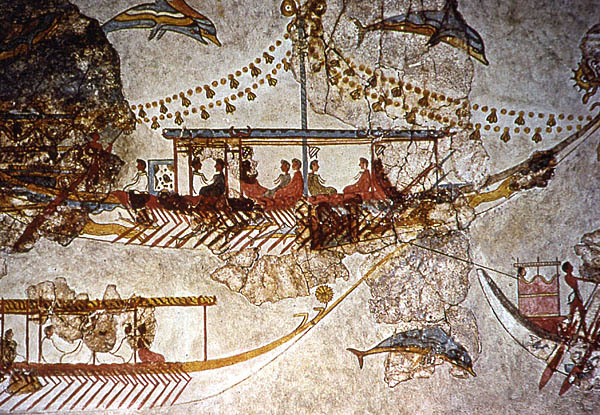
Flagship
of a fleet in Akrotiri harbor
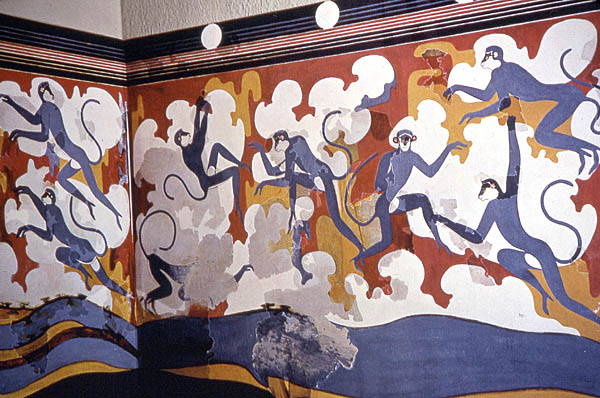
The Blue Monkeys of Thira. The monkeys were probably imported
from Egypt.
Very realistic - and deliberately painted blue to
signify their sacredness.
This
photo depicts a highly enhanced installation of the Thira frescoes
(in the manner of Sir Arthur Evans) at the Nat. Archeological Museum
in Athens, which has unfortunately since been dismantled because of
objections by the archeological purists. [September 1982]
Pitsa
Nymphaeon
Korinthia, Greece
Nat. Archeological Museum,
Athens
540 BC
Very little survives of
Greek painting except among their Etruscan inheritors in Italy
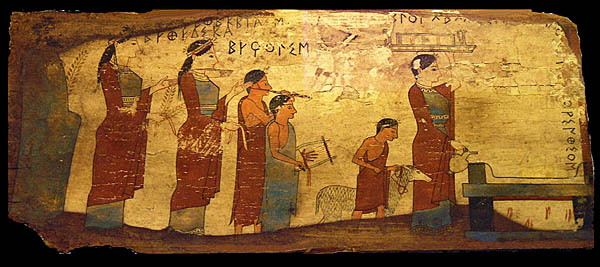
Earliest
surviving Greek painting. A votive tablet on wood showing supplicants
leading a sheep to be sacrificed to the nymphs of the place [1982]
Lucanian
Necropolis Paestum, Italy
470-320 BC
More
than 200 Lucanian tombs were discovered in the artichoke fields
around the Greek city of Poseidonia (Paestum founded 6th cent,)
during 1969-99. By the 5th cent BC the Lucanians (related to the
Sabines and Etruscans) had taken over Poseidonia. The tomb paintings
do not show Greek mythological themes but the dress and armor of the
indigenous Oscan-Samnite-speaking people - was Greek in style, and we
must assume that their painting derived from the Etruscan-Greek
sources of their northern neighbors.
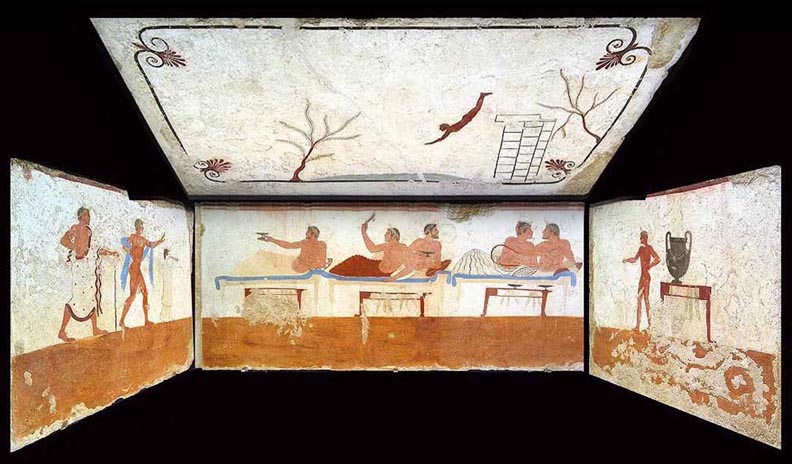
Three insides of the Tomb of the Diver (470 BC) are some of the most interesting paintings from this site: the friends of the deceased are feasting while he is diving into the afterlife....
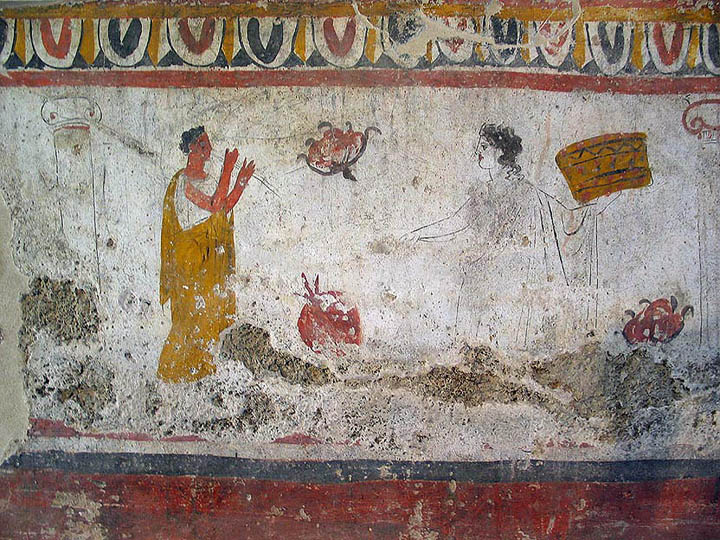
Another surprising tomb stone (350-320 BC) depicts a flute player who is conjuring his wife or lover back from the other world. They are surrounded by pomegranates, the fruits of Persephone still served at Greek funerals today.... [September 2003]
Roman
Villa Casale, Piazza Armerina, Sicily
Floor mosaics
4th
cent AD
From late Roman antiquity survive frescoes in Pompei and in the catacombs which are artistically unexciting. However, there exist numerous beautiful mosaics from the 4th-9th cent in Rome, Ravenna, and elsewhere. Less known are those of the Villa Casale.
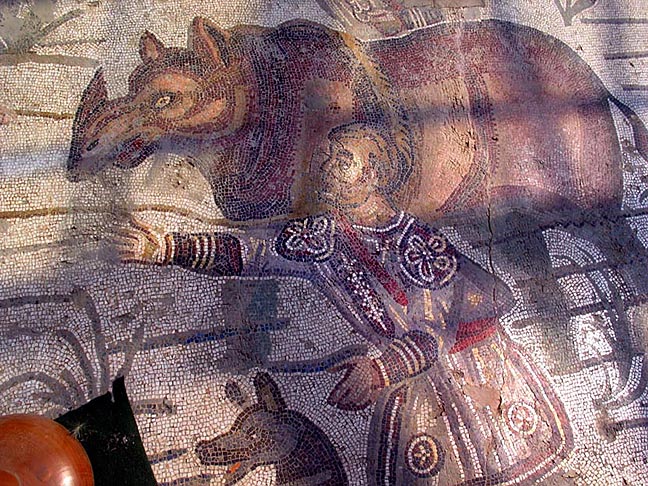
The
Great African Hunt
An Officer is trying to make his heavily armed
men attack and catch a very real rhinoceros.
At the center of Sicily, near the town of Piazza Amerina, lies a Roman villa hidden in the hills with the liveliest non-religious mosaics preserved from the time. The villa was built in the first quarter of the 4th cent AD, a "Latifundia", an agricultural estate in the granary of the Roman empire There is some indication because of the size and splendor of the estate to believe that the owner was a member of the imperial family. There are baths and a 60-meter long Triclinum with a floor mosaic showing a hunting scene in North Africa. [September 2003]
Cefalu,
Sicily,
The Norman Duomo
The “Neoplatonic” Christ
1140
AD
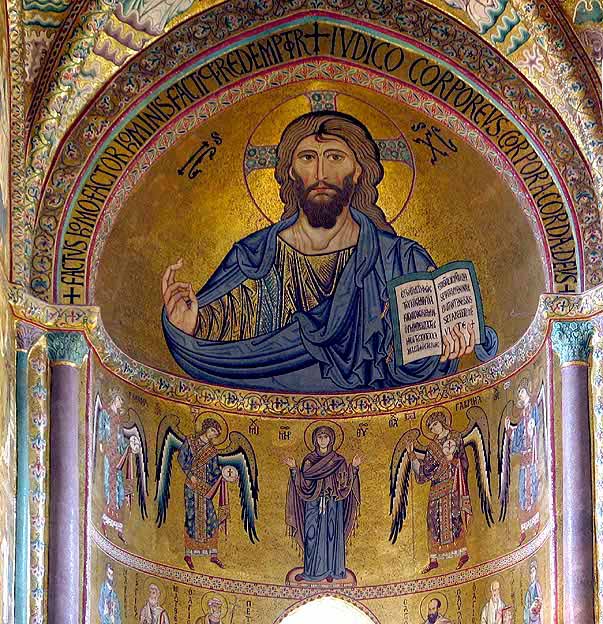
Of the
many Christian mosaics the one in the Cathedral of Cefalú is
special. Built in 1031 in the Arabic-Norman style by King Roger II
the Duomo's apse mosaic was designed by Constantinopolean craftsmen
just after the East-West schism. Their Christ is an ascetic, almost
romantic man according to the neoplatonic canon of the
“Pseudo-Dinonysos” then still adhered to in Constantinople. Roger
II knew no better, his Capella Palatina in Palermo still follows the
same old-fashiond Byzantine iconography. But William I, Roger's son,
would, 30 years later in building the Duomo of Montreale succumb to
the new Latin-West-Roman teachings. [September 2003]
Cimabue
(Cenni di Pepo dit. Cimabue)
The
Crucifixion
Assisi,
San Francesco, Upper Church
1283 AD
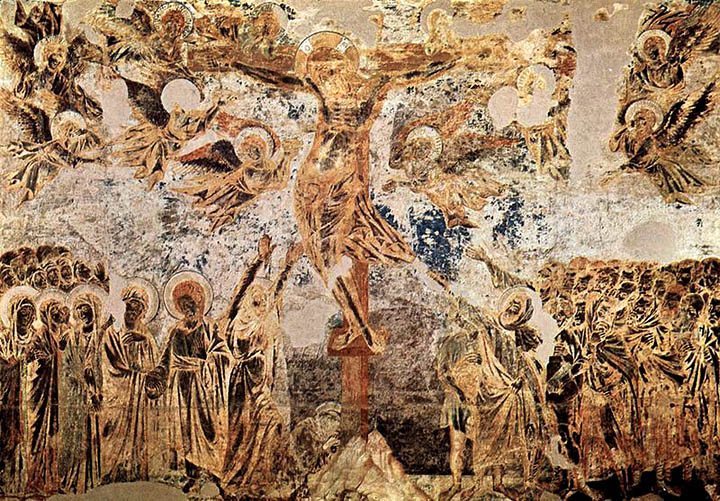
It was Cimabue (1240-1302) who broke with the Byzantine canon of painting and for me this crucifixion in Assisi is the best example of this new Italian style: The dramatic crowds on both sides of the crucifix, the emotional angels, and the distraught figure of Mary under the cross are unheard of in Byzantine Orthodoxy. - (Only in Georgia do you find similar scenes, e.g., at Ateni, 13th cent). [2002]
Giotto
(Giotto di Bondone) 1266-1337
Lamentation
Assisi, San
Francesco, Upper Church
1290 AD
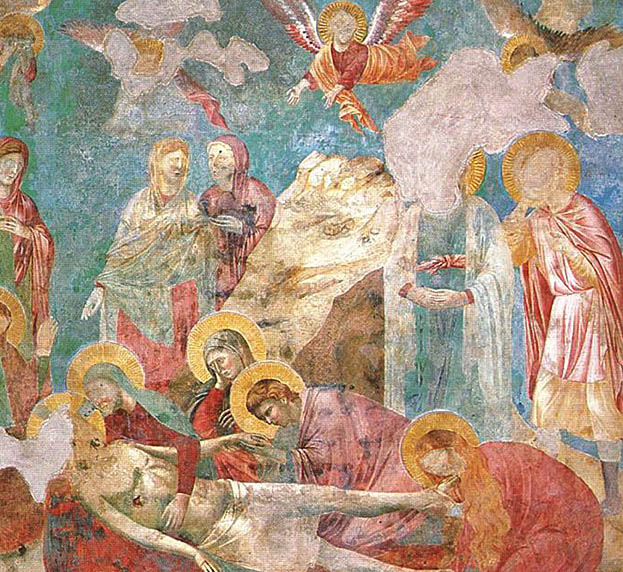
Giotto,
Lamentation, Upper Church of San Francesco, Assisi
It is, of course, Giotto, who is credited with “inventing” the Renaissance. I often find him “wooden”, his celebrated figures stark. So the discovery of this emotional fresco in Assisi was a great surprise. [2002]
The
Florentine Pre-Renaissance.
1285
- 1422
From among all the
paintings of the Florentine tre- and quattrocento three have
fascinated me for the longest time. They are now in the Uffici in
Florence: Duccio's Madonna Rucellai (1285), Giotto's Ognissante
Madonna (1310), and Masaccio's San Giovenal Triptych (1422) All three
are variations on one of the most hieratic subjects: The Madonna in
Majesty. Two hundred years aerlier, before 1300, this Madonn had
occupied the apsis of all major Byzantine cathedrals. [1952, 2002]
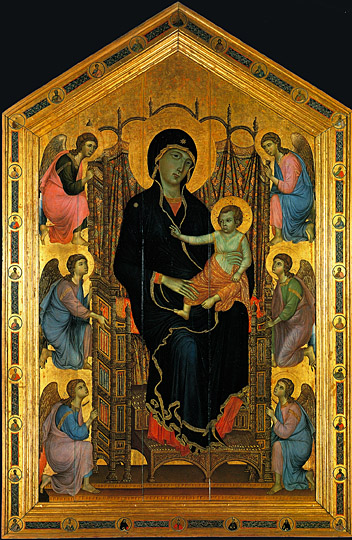
Duccio,
“Madonna Rucellai” originally at Santa Maria Novella in
Florence
1285 AD
The changes brought to her iconography by the renaissance are subtle. Duccio di Buoninsengna (1260-1319) was from Siena yet his "Rucellai Madonna" is a seminal painting of the Florentine Renaissance. Duccio's client was a modern man. By comparison Duccio's Sienese works are in the old-fashioned Byzantine style. Siena was a conservative place, and during the next 35 years he remained its greatest master painting in the Byzantine style.
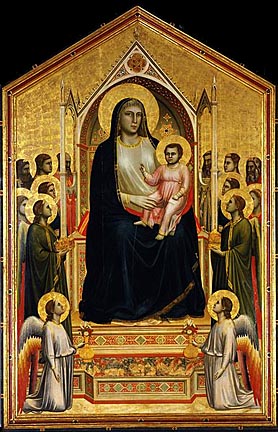
Giotto, “Ognissante Madonna”, from the church of
Ognissante in Florence
1310 AD
Giotto's
Ognissante Madonna adheres as well to the old rules: a stiff
perspective, serious almost sinister faces, and a formal hieratic
iconography.
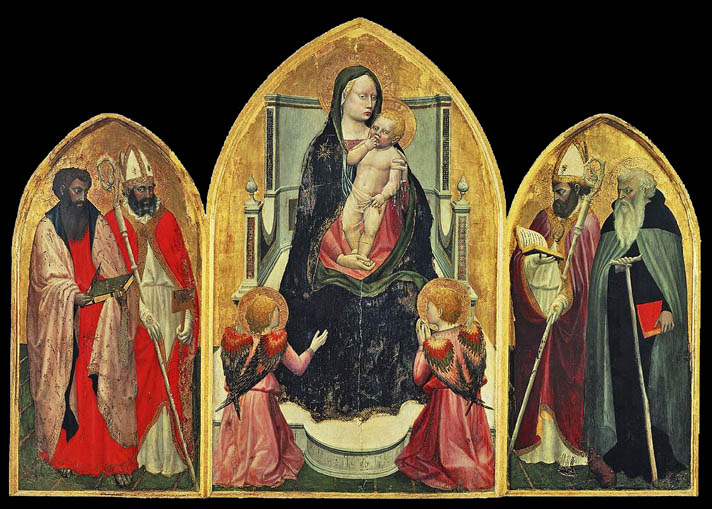
Masaccio (Tommaso di Ser Giovanni di Simone)
from the
church of St. Pietro, Cascia di Reggello, Fiorentino
1422
AD
Hundred
years later the Renaissance had reached even the remote villages of
the Fiorentino. Masaccio's triptych is his earliest painting. It was
only discovered in 1961 and has recently been restored. It represents
a revolution in Florentine painting. Look at the village bumpkin with
the thumb in his mouth and the daring colors, not to mention the
perspective rendering. A comparison of the three altar pieces shows
the advances of Florentine painting in the intervening 120 years.
Massacio became the revolutinary painter of the Capella Brancacci
(1426) before he died too early in 1429. [2002]
Florence,
Santa Maria del Carmine
Capella Brancacci
1423-1430
The restored Capella Brancacci

If
there is one place where the birth of the Renaissance took
place it would be the Capella Brancacci in Florence. Since 1952 I
have visited this narrow chamber four times. At Easter 1994 on our
way from Rome we arrived in Florence a few weeks after the renovated
chapel had been opened to the public. [1994, 2002]
In
1423 Felice Brancacci hired Masolino da Panicale to paint the chapel.
Masolino's associate, 21-year-old Masaccio, 18 years younger than
Masolino, assisted. During painting Masolino was called to Hungary,
where he was painter to the king, and the commission was given to
Masaccio. By the time Masolino returned he was learning from his
talented former student. However, Masaccio was called to Rome before
he could finish the chapel, and died in Rome at the age of 27.
Masaccio
(1401-1428)
The Tribute Money
1426
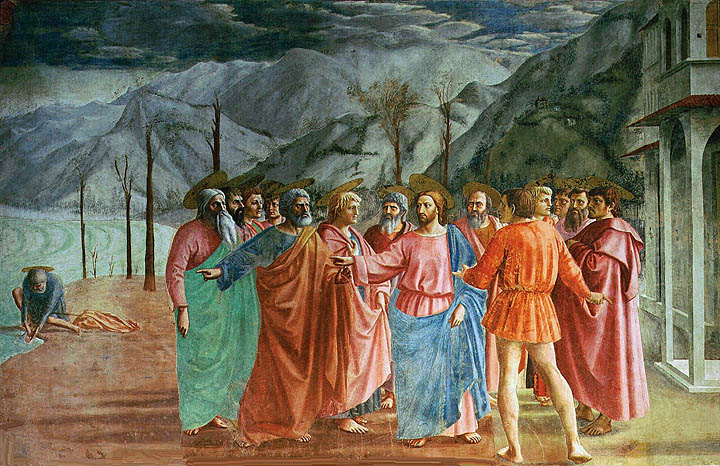
The
Tribute Money, 1426
The restored colors of the murals were
shocking. Look at the greens and various shades of red in Masaccio's
celebrated painting:
Paolo
Uccello (1397-1475)
The
Great Flood
Florence,
Santa Maria Novella,
1432-38
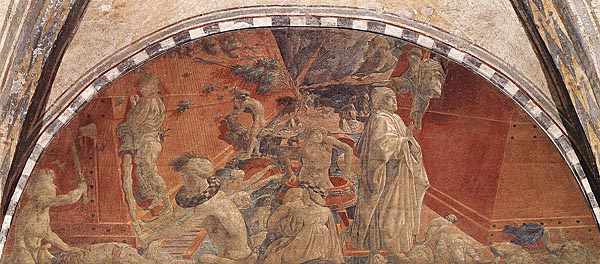
Starting In 1432 Uccello
painted a cycle of frescoes in the Green Cloisters of Santa Maria
Novella. Their poor condition adds to their enigmatic subjects.
Perspecitive construction was his preoccupation. His late Flood
fresco is the non-plus-ultra of Brunelleschi's perspective
innovations.
Uccello was long thought to be significant
primarily for his role in establishing new means of rendering
perspective that became a major component of the Renaissance style.
The 16th-century biographer Giorgio Vasari said that Uccello was
"intoxicated" by perspective. Later historians found the
unique charm and decorative genius evinced by his compositions to be
an even more important contribution. Though in ruinous condition,
they indicate the immense difficulties faced by artists of his time
in taking advantage of new developments without giving up the best in
traditional art. Still, to me the Flood is, after Piero della
Francesca's Arezzo cycle, thematically the most exciting fresco of
the quattrocento. [1994, 2002]
Piero
della Francesca (1416-1492)
Capella
Maggiore
Arezzo
Basilica di San Francesco,
1452-66
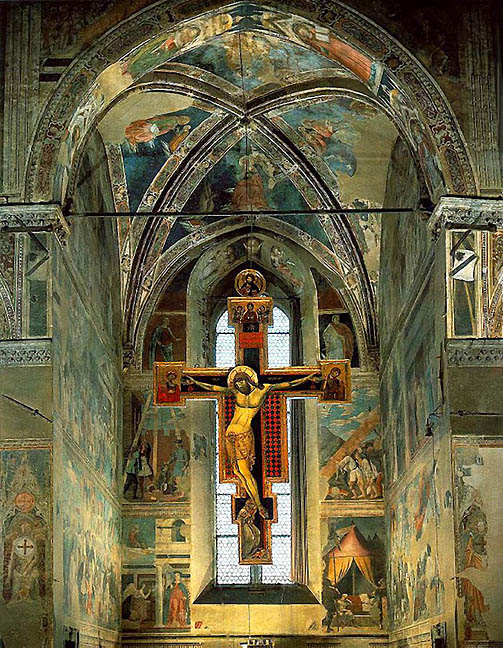
In
the Basilica of St. Francesco in Arezzo Piero della Francesca filled
the Cappella Maggiore with a cycle of idiosyncratic frescoes of an
equally unusual "Legend of the Discovery of the True Cross",
the "Meeting of King Solomon and the Queen of Sheba", and
two large frescoes of the "Death of Adam".They are his
major works. [2002]
Piero
della Francesca
The Meeting of King Solomon and the Queen of
Sheba
Arezzo
Capella
Maggiore
1452
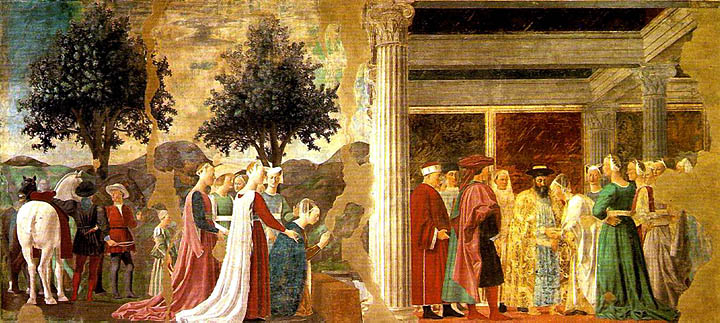
Piero
della Francesca, virtually forgotten for centuries after his death,
but regarded since his rediscovery in the early 20th century as one
of the supreme artists of the quattrocento. - He was a slow and
thoughtful worker and often applied wet cloths to the plaster at
night so that contrary to normal fresco practice, he could work for
more than one day on the same section.
Piero
della Francesca
The Resurrection
Museo Civico
Sansepolcro
1458
Piero
della Francesca's enigmatic but powerful Resurrection. The fresco has
been detached and is now in the Museo Civico in Sansepolcro.
[2002]
Many consider this fresco the most extraordinary painting
of all times. Aldous Huxley, for instance, says: "One of Piero's
greatest masterpieces, painted probably just before his journey to
Rome in 1458. This exemplifies Piero's ability to use archaic
iconographic elements, belonging to the repertory of popular sacred
images, yet placing them in an entirely new cultural and stylistic
context."
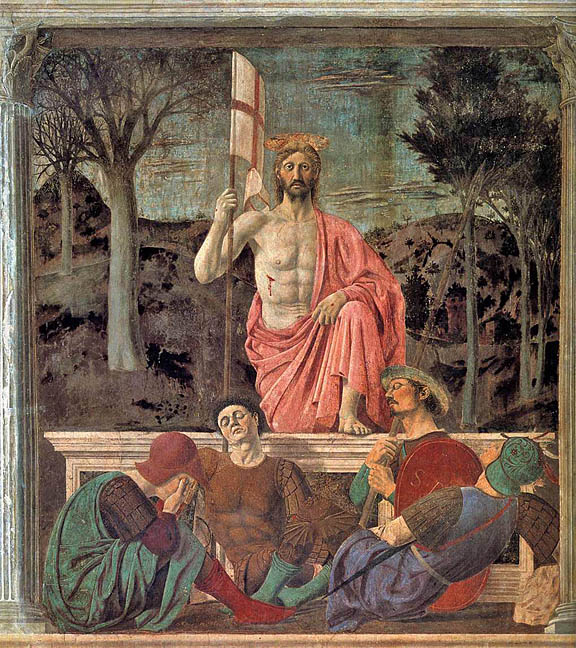
Within a framework, formed at the sides by two fake marble columns, the composition is divided into two separate perspective zones. The lower area, where the artist has placed the sleeping guards, has a very low vanishing point. Alberti, in his theoretical writings, suggests that the vanishing point should be at the same level as the figures' eyes. By placing it on a lower level, Piero foreshortens his figures, thus making them more imposing in their monumental solidity. Above the figures of the sleeping sentries, Piero has placed the watchful Christ, no longer seen from below, but perfectly frontally. The resurrected Christ, portrayed with solid peasant features, is nonetheless a perfect representative of Piero's human ideal: concrete, restrained, and hieratic. The splendid landscape also belongs to the repertory of popular sacred images: Piero has symbolically depicted it as half still immersed in the barenness of winter, and half already brought back to life - resurrected - by springtime. From Web Gallery of Art
Piero
della Frencesca
The Flagellation of Christ
Urbino
Palazzo Ducale
Museo Civico
1460
Much
of Piero's later career was spent at the court of Federico da
Montefeltre at Urbino. There he painted the portraits of Federico and
his wife (Uffizi, Florence, 1465) and the curious "Flagellation".
[2002]
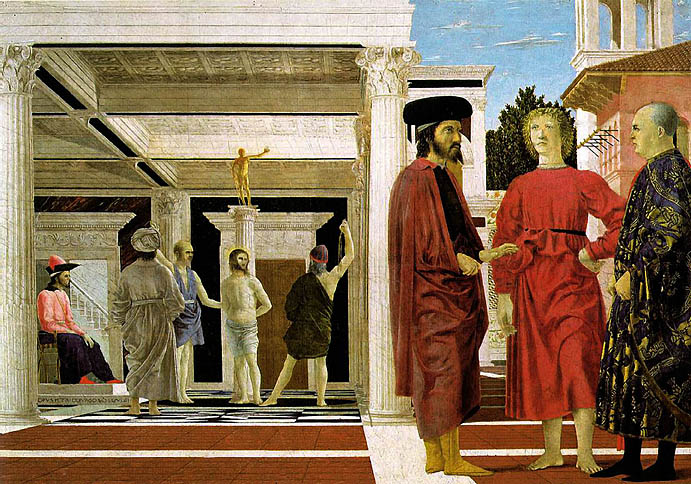
The Flagellation panel is one of his most enigmatic works, which has called forth varied interpretations. During his stay in Urbino he devoted himself to mathematics and perspective. In fact, in his time della Francesca was primarily known for his mathematical treatises - his astringent paintings had to wait for the 20th century to be appreciated. This explains in part this curious painting, in which the Emperor of Constantinople (with beard) makes an appearance. From Web Gallery of Art
Benozzo
Gozzoli (1421-1497)
Procession of the Magi
Cappella
dei Magi
Palazzo Medici-Ricardi
Florence
1460
Gozzoli
was the master of colorful story-telling. This cycle, splendidly
restored, is his most beautiful set of frescoes. A feast for the
eyes. In a pretext for showing pictures of all the Medici, he
depicted them in the annual Procession of the Three Kings winding
their way through an imaginary Tuscan landscape. [2002]
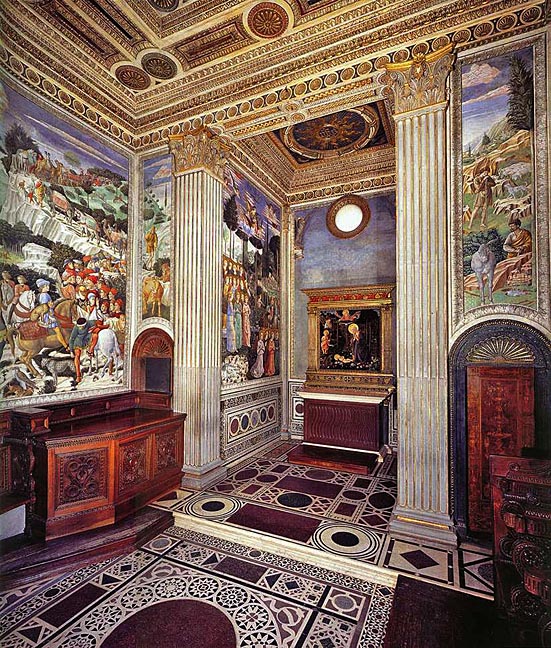
View of the
Capella Medici-Ricardi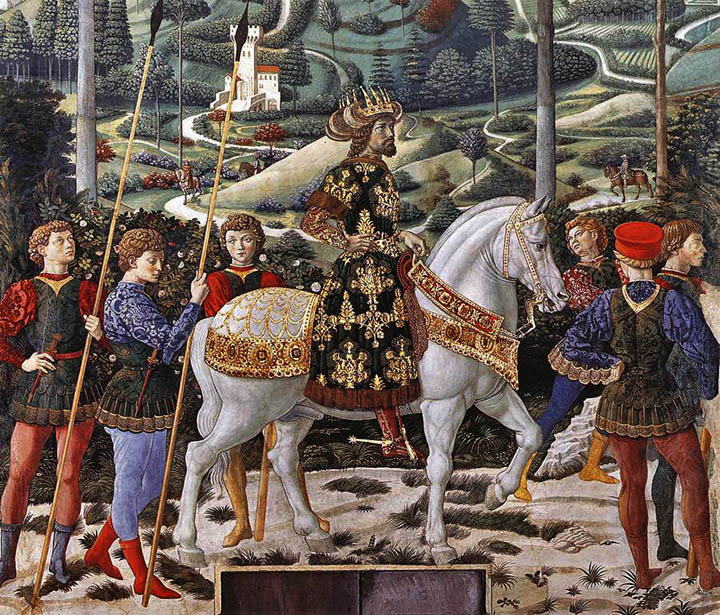
The Procession of the Middle King – being a portrait of the
last Emperor Paleologos of Byzantium
who was seeking foreign aid
to defend his last refuge Trapezond against the Ottoman Turks.
During
his formative years Benozzo Gozzoli collaborated with Lorenzo and
Vittorio Ghiberti on the third bronze door of the Baptistery,
Florence (1444), with Fra Angelico at San Marco in Florence (1444-45)
and in the chapel of Pope Nicholas V in the Vatican (1447), and again
with Fra Angelico on the ceiling of the Chapel of San Brizio in the
cathedral of Orvieto (1448). He painted his first independent
frescoes in Montefalco in Umbria for the church of S. Francesco
(1450-52).
Gozzoli's pleasing narrative style made him one of the
most desired fresco painters of Tuscany: with cycles in Florence, San
Gimignano, and Castelfiorentino. From Web
Gallery of Art.
Roger van der Weyden (1399-1464)
Descent from the Cross
Madrid
Museo del Prado [1977]
1435
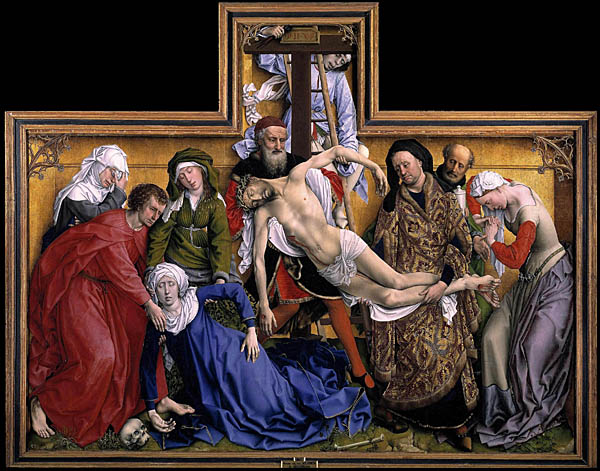
Roger van der Weyden can be considered the founder of the "Northern Renaissance" and this Descent is beyond doubt his greatest painting. More meticulously executed than his Italian contemporaries he lavished an almost super-realistic attention to the details of composition and faces: the fainted Mary echoing the body contours of the dead Christ, the expression of grief of the women. This work was arguably the most influential Netherlandish painting of Christ's crucifixion. It was copied and adapted on a large scale in the two centuries after its completion.
The painting was commissioned by the Greater Guild of Crossbowmen of Leuven and was originally installed in the Chapel of Our Lady Without the Walls. Eventually the painting was acquired by Mary of Austria, the sister of Holy Roman Emperor Charles V, after whom it passed into the hands of King Philip II of Spain.
Hieronymus
Bosch (1450-1516)
The Garden of Earthly Delights
Madrid
Museo del Prado [1977]
1467-1470
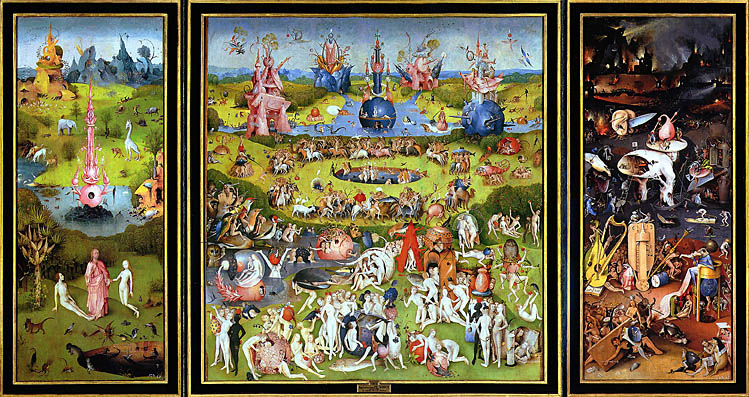
While
the Florentines explored such formal aspects of painting as
perspective and color, the Northern Europeans continued to explore the
mystical and spirital dimensions of the fading Gothic: e.g.,
Hieronymus Bosch and Mathias Grünewald. - Curiously Bosch employed
Italian neoplatonic motives: his Garden
of Delights
appears to be based on the philosophical teachings of Marsilio Ficino
and Pico della Mirandola. [1977, 2001]
The Garden has another
distinction, painted in 1468-70 it is Bosch's earliest major work. He
was barely 20.
And a final conundrum: why did all major Bosch
paintings (save for the Triptych
of theTemptation
of Saint Anthony)
end in the possession of the most Catholic King Philip II of
Spain?
For further musings on these and other Bosch puzzles
read The
Life and Times of Hieronymus Bosch
Giorgione
(Giorgio Barbarelli da Castelfranco, 1477-1510)
The Tempest
Gallerie dell'Accademia
Venice
1506
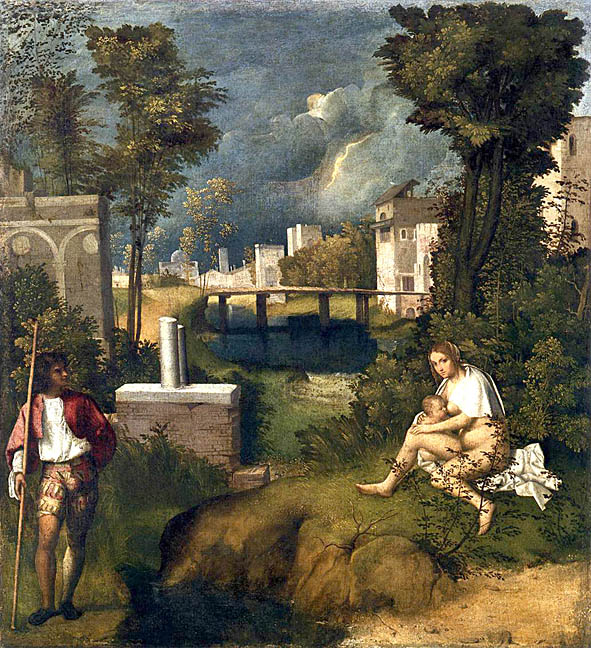
This
small paiting of 82 x 73 cm has a rather overbearing significance in
Western painting: it is the first landscape painting where the
landscape is not the mere backdrop for a mythological or allegorical
collection of people: This is a real thunderstorm about to break over
the idyllic pastoral scene, a small town, a soldier and a nude woman
feeding her baby. - Who are these two people? - The painting has
namely yet another claim : it is the first nude who is not a Roman
Venus, a nymph or has another excuse for being naked... - A lot has
been written trying to explain the existance of these two under the
billowing clouds.
I believe that the solution is very simple,
that Giorgione had no allegorical thoughts in his mind - he simply
described the homecoming of a soldier to his wife and child, whom he
sees for the first time - hence his smile. The clouds of war are in
fact receeding
in the distance. - Of course, this leaves the question of how
Giorgione considered such a banal event worth one of his loveliest
paintings - and that
may be the most remarkable novelty of this canvas. [Easter
1994]
"Though he died at 33, Giorgione left a lasting
legacy to be developed by Titian and 17th-century artists. Giorgione
never subordinated line and colour to architecture (perspective), nor
an artistic effect to a sentimental presentation. He was the first to
paint landscapes with figures, the first to paint genre, movable
pictures in their own frames with no
devotional, allegorical, or historical purpose and the first whose
colours possessed that ardent, glowing, and melting intensity which
was so soon to typify the work of the Venetian School." Quoted
from wikipedia
Michelangelo
The
Sistine Chapel
Vatican
Rome
1508-1512
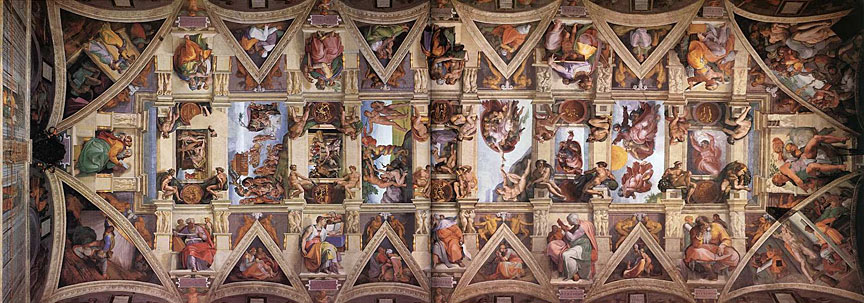
The restored ceiling [2005]
Michelangelo's ceiling of the Sistine Chapel needs no introduction. It stands here primarily as a commemorative to a visit with Barbara in 2005 when the restoration had just been opened to the public. The Last Judgment was still under wraps. - We fought our way to the chapel among thousands of people, saw nothing of the Vatican treasures – and came back deeply moved by the new colors. - Someone else had permission to photograph the miracle.
Matthias
Neidhard Grünewald
The Isenheimer Altar
Colmar
Museum
Unter den Linden
1515
Contemporaneously
with Giorgione and Michelangelo Grünewald painted a most ecstatic and
flamboyantly religious altar retable in high-Gothic style, the Isenheimer Altar now in Colmar. [Barbara 1979]
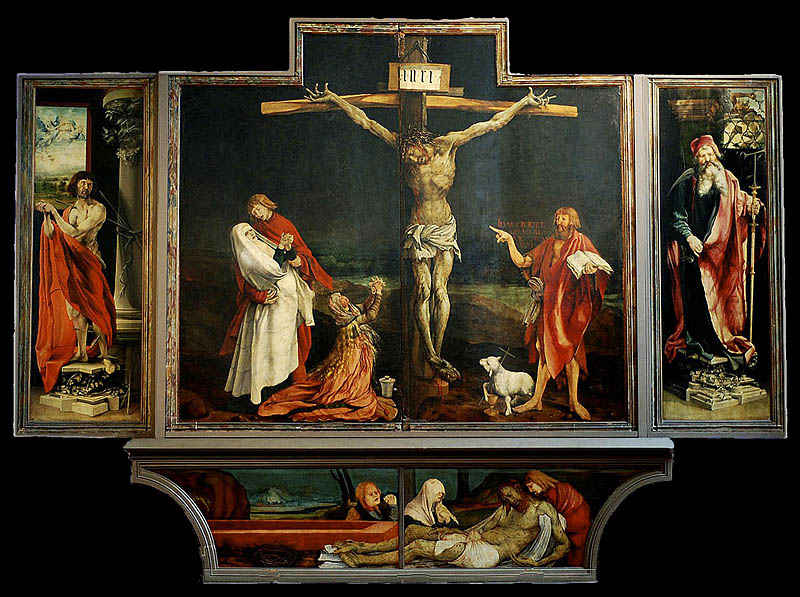
View of the closed altar
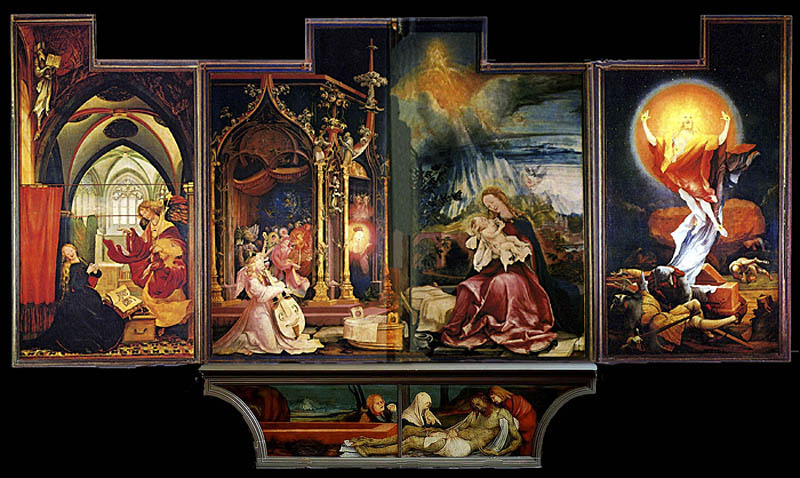
View of the open altar
The
altar is composed of
nine
images on twelve panels
which
are arranged on double wings to present three views, according to the
season or occasion. The first view with the outer wings closed shows
a Crucifixion
flanked
by Saint Sebastien and Saint Anthony, with a predella showing the
entombment. When the first set of wings is opened, the Annunciation,
Angelic Concert,
Mary
bathing Christ, and the Resurrection
are
displayed. The third view (shown below) discloses a carved and gilded
wood altarpiece by Nicolas Hagenau (1490) flanked by a Temptation of
St. Anthony
and
Anthony's visit to St. Paul.
In addition to being Grünewald's
greatest surviving work, the altarpiece is 2.65 metres high and over
5 metres wide at its fullest extent !
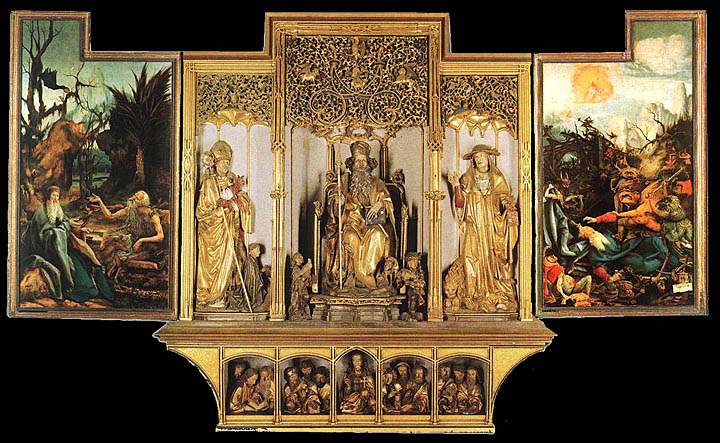
Third view, Nicolas Hagenau's gilded-wood altar with Grünewald's St. Anthony panels attached to it
The
altar was commissioned by the Anthonite monks of Isenheim, 15 km
south of Colmar, for their church. The monks would place the
terminally ill under this altar- some say victims of the bubonic
plague, some of syphilis, and others of “St. Anthont Fire” caused
by a grain fungus. The altar barely escaped destruction during the
French revolution and in WW I. There is nothing left to see in
present Issenheim, Alsace, the monastery burnt down.
Jacopo
Pontormo (Jacopo Caruzzi) (1494-1557),
Deposition and
Annunciation
Florence
Santa Felicita
Cappella Capponi
1526-28
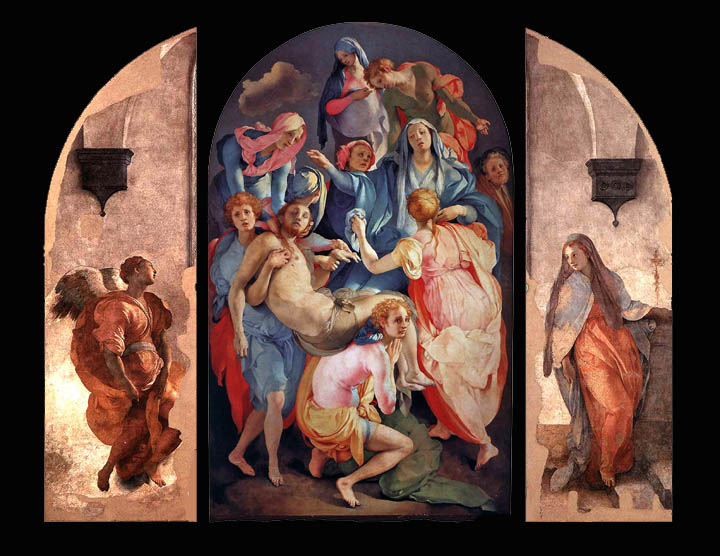
Pontormo is considered a mannerist and hence is often overlooked. I passed Santa Felicita many times until one day I looked inside - and discovered this superbly restored altar. - It has become one of my favorite paintings. At times I believe that the women surrounding Christ are different incarnations of one and the same woman - including Christ! - The altar is framed by an al fresco Annunciation also by Pontormo. [2002]
Jacopo
Pontormo
The Visitation
Florence,
Uffici, from Santa
Anunzziata
1528-29
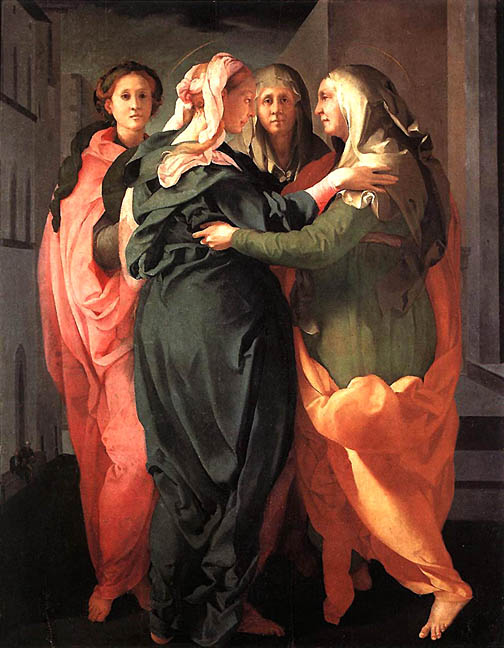
Having
been primed to Pontormo, I found this emotionally restrained painting
by him in the Uffici. [2002]
Jacopo Pontormo, full of restless
movement and disconcertingly irrational effects of scale and space -
put him in the vanguard of Mannerism. In 1518 he completed an
altarpiece for the Church of San Michele Visdomini, Florence, that
also reflects its agitated - almost neurotic - emotionalism a
departure from the balance and tranquillity of the Renaissance.
The
emotional tension apparent in his work reaches its peak in Pontormo's
masterpiece, the altarpiece of the Entombment (c.1526-28) in the
Cappella Capponi at Santa Felicitá Florence. Painted in
extraordinarily vivid colors and featuring deeply poignant figures
who seem lost in a trance of grief. From Web
Gallery of Art.
Titian
(Tiziano Vecelli 1488-1576)
Emperor Karl V
München
Alte
Pinakothek
1548
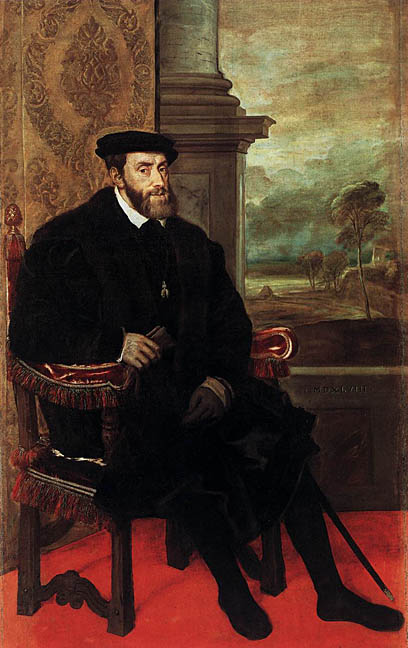
This
large portrait was painted during the imperial Diet of Augsburg in
1548. It is, however, thought that Titian did not create the work
single-handedly. There is an awkwardness in the foreshortening of the
perspective of the chair; and the red carpet is an isolated colour
contrast, very unusual in Titian's work. But there are also areas of
high quality. The face, above all, demonstrates a fine power of
observation. The deformation of Charles' lower jaw has been
skillfully concealed. The intimate atmosphere of the painting, which
contains no regal affectations, is unusual in Titian's portraits of
rulers. [1972, 1994]
Titian was the first Italian artist to
acquire a truly international clientele, and this owed much to the
fame of his portraits. Portraiture provided a constant stimulus for
his interest in psychology as well as an opportunity to meet and
cultivate potential patrons. His artistic goals conformed to the
expectations of a time when portraiture was more and more being used
to fashion a self-conscious public image: an adequately flattering
likeness, an account of the sitter's public or private status that
impressed or at least was of some interest, and a record of character
that was sufficiently reticent not to be intrusive or offensive but
enough to bring the subject to life. It had been commonplace since
antiquity to praise artists for making their sitters come alive, but
the repeated praise Titian received in this respect indicates he was
perceived as breaking new ground. He does this in two ways: first, by
describing his sitter's personality or state of mind much more
clearly and specifically than other Italian Renaissance artists, with
the notable exception of Raphael; secondly, by marrying this
psychological profile with an indication of the sitter's social
standing - always an essential function of portraiture - in a way
that allows the artist to flatter under the guise of telling the
truth. From Web
Gallery of Art
El
Greco (Domenikos Theotokopoulos, 1541-1614)
Seven large canvasses
painted for the chapel of the Collegio de Dona Maria
Madrid
Museo del Prado,
Madrid
1596 – 1600
The
Dona Maria de Aragon chapel was the most important commission El
Greco received, and he was paid just under 6000 ducats for it, a vast
sum, and more than he earned for any other work. It was here that he
first fully realised the traits of his late, 'mystical' style -
elongated forms, flickering effects of light, colour combinations
that verge on dissonance (copper-resinate green, rose-to-magenta,
golden yellow and blue), and an emphasis on ecstatic gestures and
expressions [1997]
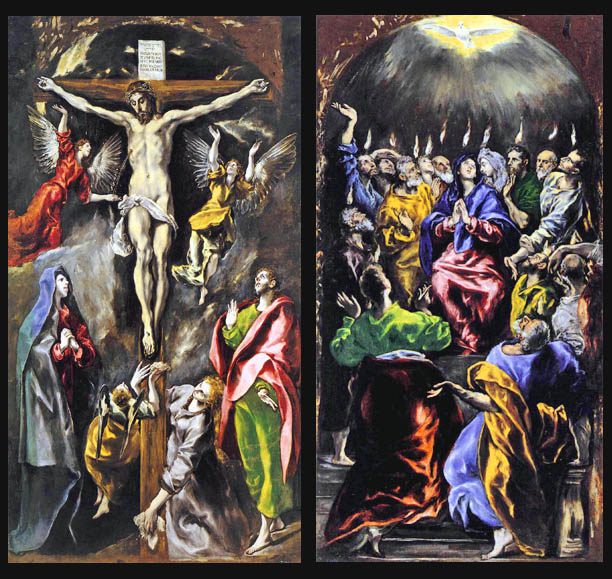
Nativity and Baptism, (350 x 144 cm)
Following the
suppression by Joseph Bonaparte of the religious orders in Spain, the
chapel with its paintings was dismantled in 1810. No detailed
description of it survives, but according to a document of 1814 it
comprised seven paintings and six sculptures. There has been much
debate in recent years over the altarpiece's original appearance, but
there is considerable agreement that it comprised five paintings
today in the Prado, The Resurrection, The Crucifixion, The Pentecost,
The Baptism of Christ and The Annunciation, and a sixth, The
Adoration of the Shepherds, in Bucharest. The seventh painting is
presumed lost, and it has been suggested that it may have been a
Coronation of the Virgin.
When we visited the Prado in the
summer of 1997 it was being reorganized and the 5 paintings from the
Dona Maria Chapel had been squeezed next to each other into a small,
very high room. The effect was over powering, the distortions and
colors even worse than if seen from a distance. I fled but Barbara
spent another hour among them.
El
Greco
The Opening of the Seventh Seal
(according to the
Revelations of St. John)
Metropolitan Museum
New
York
1608-1614
Searching
the internet for reproductions for my gallery I came across this El
Greco which I only had a dim memory of.[1958]
.jpg)
The Opening of the Fifth Seal, (225 x 200
(375) cm, truncated top) 1608-14
The Opening of the Fifth Seal (or The Fifth Seal of the Apocalypse or The Vision of Saint John, Book of Revelation 6:9-11) was painted in the last years of El Greco's life for a side-altar of the church of Saint John the Baptist outside the walls of Toledo. In the 19th century the poorly preserved canvas was “restored”and cut by at least 175 cm on top. After being owned by the Spanish painter Zuloaga it was acquired by the Metropolitan. Zualaga showed the painting to Rilke and to Picasso, whom it inspired to paint Les Demoiselles d'Avignon.
Rembrandt
van Rijn (1606-1669)
The Three Crosses
Rembrandthuis
Amsterdam
1653
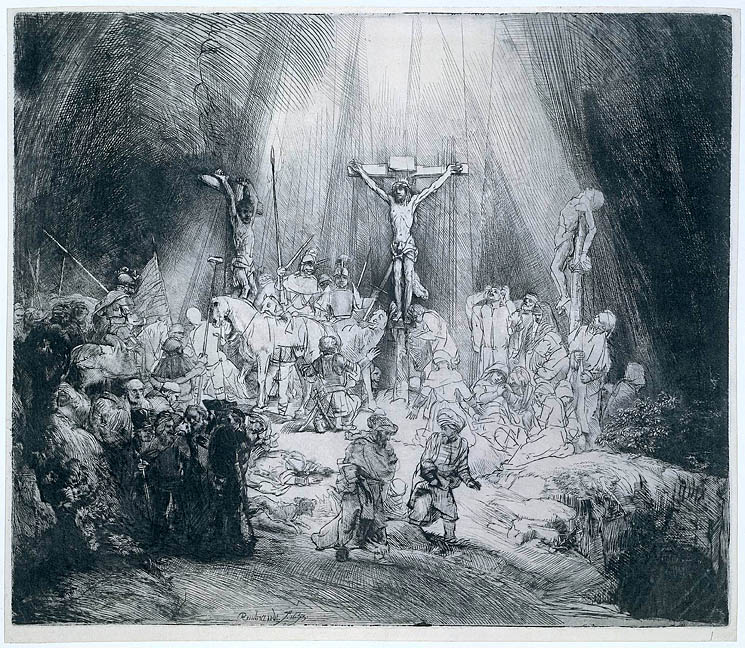
The
Three Crosses, drypoint
etching, 1653
The
“Man in the Gold Helmet” was my first infatuation with Rembrandt
[1950]. A visit to the Rembrandthuis in Amsterdam [2001] changed all
that. His prints and drawings are – even more than with Dürer -
much more exciting.
Johannes
Vermeer
Pregnant Woman reading a
letter
Rijksmuseum
Amsterdam
1662
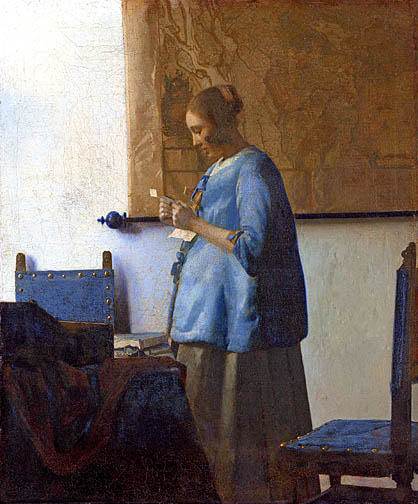
Pregnant Woman reading a Letter 1662
A very similar thing happened to me with the glowing paintings of Vermeer. I first encountered his “Girl with the Red Hat” after a conference in Washington, DC [1993]. I collected a webpage with all his paintings in 1995, but Vermeer's colors cannot be reproduced, one has to see his small pictures in loco. On our grand museums tour in 2001 I made a systematic search of Vermeer's pictures in Amsterdam and Belgium and this unpresumptous oil became my favourite. [1993, 2001]
Dominikus
Zimmermann
The Church on the Wies, Bavaria
1745-54
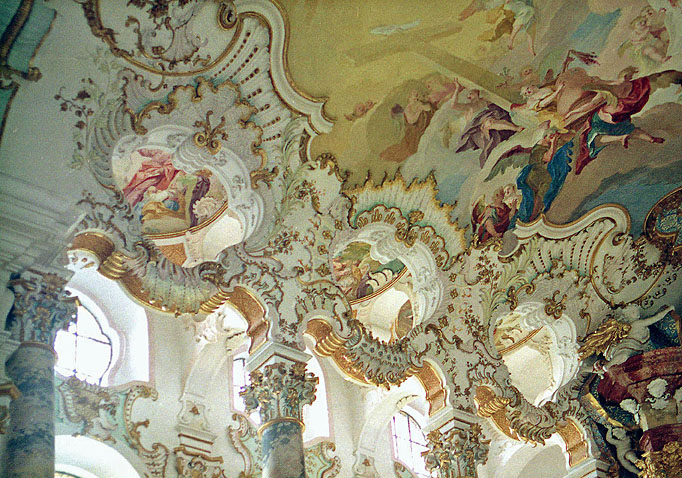
For me the synthesis of architecture, stucco, and painting combined with the music of Mozart in the village churches and monasteries of Bavaria is the highest expression of Baroque art. None of the great Italian examples can compete with them - maybe with the exception of Michelangelo's Sistine Chapel in Rome. But in the Sistina there is no organ to fill the space with heavenly music.... [1951, 1972, 2000]
William Turner 1789-1862
National Gallery, London
1838
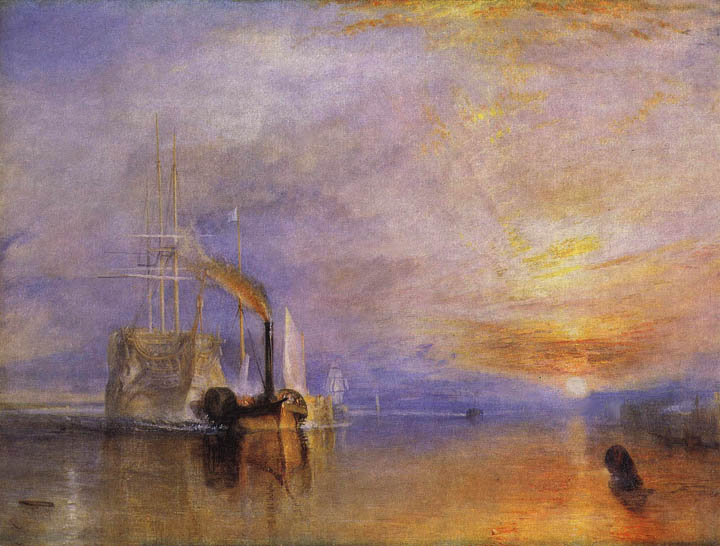
The Good Ship Temerain Being Towed to her Last Berth, 1838
At the end of our long Museums Tour through Holland and Belgium (2001) Christine and Rudolf Scharlau in Hagen had a surprise for us: there was a large Turner exhibition at the Museum Folkwang in Essen. Would we join them? We did and for half-a-day we succumbed to the heights of Victorian Romanticism.
Claude
Monet 1840-1926
Musee Marmottan, Paris
1872
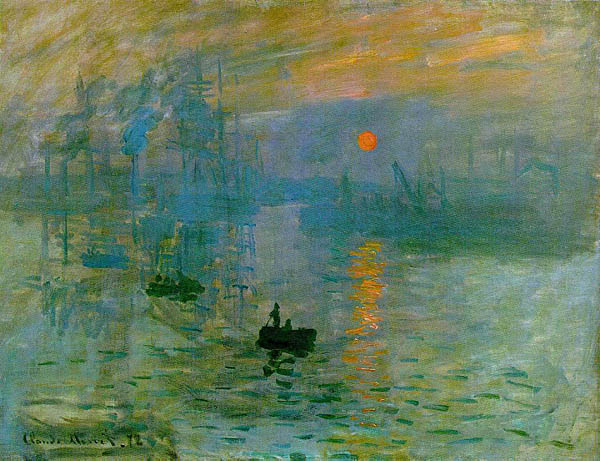
Le soleil se lève, 1872
The Museum
Marmottan is often overlooked by visitors to Paris, and yet it houses
a unique collection of Monets, in which the painter pushed the
impressionist style to its abstract limits. This sunrise over
an industrial landscape (London?) is one of them. [1998]
Piet
Mondrian 1872-1944
Gemeente Museum
The Hague
The
Early Mondrian 1893-1908
Mondrian
is well known for his geometrical abstracts, one has to visit the
Gemeente Museum in the Hague to discover his underlying intimate
spiritual and philosophical side. In 1908 he became interested in the
theosophical movement launched by Helena Petrovna Blavatsky in the
late 19th century, and he joined the Dutch branch of the Theosophical
Society in 1909. The thinking of Blavatsky and Rudolf Steiner's
Anthroposophy significantly affected the further development of his
painting. The formalism of Mondrian's later work masks his life-long
search for spiritual gnosis.
His early paintings show only a
faint shadow of the abstraction to come: a series of canvases from
1895 to 1908, which depict dim scenes of indistinct trees and houses
with reflections in still water. These paintings are firmly rooted in
nature, and it is only our knowledge of Mondrian's later achievements
that leads one to search for the roots of his future abstraction in
these works.[2001]
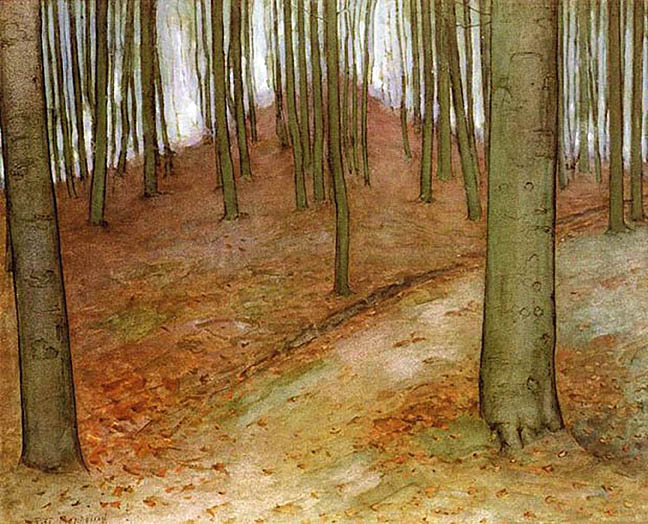
Woods, 1900
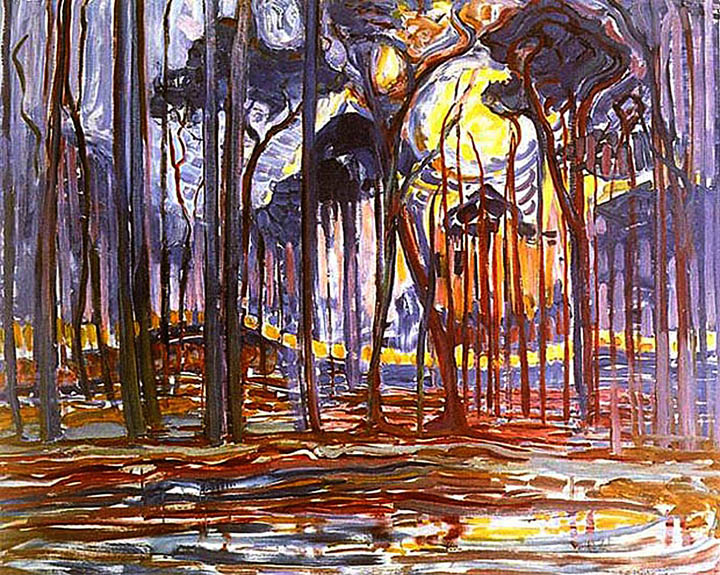
The Woods near Oele, 1908
Paul
Gauguin 1848-1903
Pushkin Museum
Moscow
1892
Originally
acquired by two wealthy textile manufacturers in the last decades
before the revolution the art collections of Ivan Morozov and Sergei
Shchukin are now the center of attraction at the Pushkin Museum in
Moscow and the Hermitage in St. Petersburg.
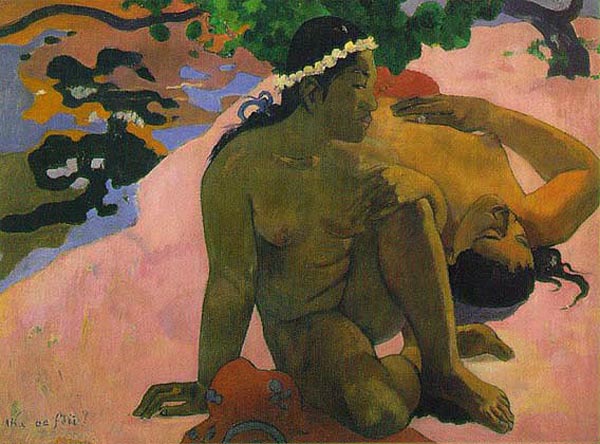
Aha oe feii? (Are You Jealous?), 1892
Was it the the surprise of finding this Gauguin unexpectedly, or the heightened awareness of being in Moscow in in the middle of the Cold War - Gauguin's Pink Beach burned a triangular hole into my retina, which lasted for years.... [1977]
Pablo
Picasso
Les Demoiselles de Avignon
MOMA, New York
1907
The following three paintings by Picasso and Matisse are considered corner stones of 20th cent painting. They are huge and (in my eyes) not particularly beautiful. Picasso's pink Ladies of Avignon founded Cubism, the pair of Matisse canvasses for Shchukin Fauvism. Both belong to a wave of primitivism, which goes back to Gauguin, while the Demoiselles are connected even to El Greco. - Never mind the labels attached to movements in art criticism.... [2001]
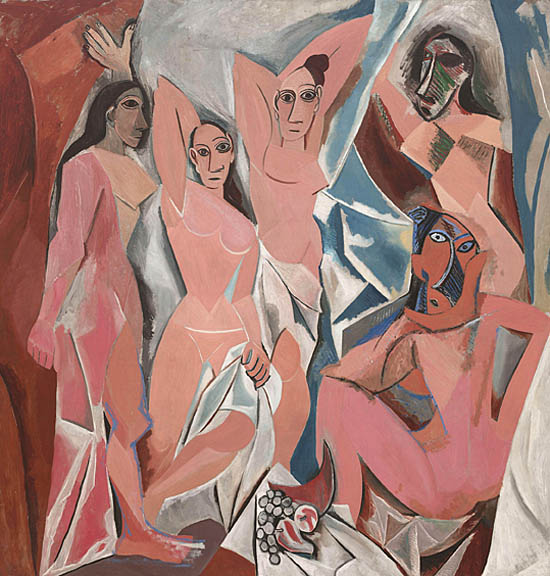
Les Demoiselles de Avignon, 230x240 cm, 1907
At
the time of its first exhibition in 1916 – nine years after Picasso
had painted it - the painting was still considered immoral. Picasso
had always referred to it as Le
Bordel d'Avignon,
but art critic André Salmon, who managed its first exhibition titled
it Les
Demoiselles d'Avignon
to lessen
its scandalous impact on the public. Picasso never liked Salmon's
title, and would have preferred las
chicas de Avignon
instead.
In
1988 New York art-critic Leo
Steinberg summed up the revolutionary nature of Les
Demoiselles:
“Picasso was resolved to undo the continuities of form and field which Western art had so long taken for granted. The famous stylistic rupture of the painting at right turned out to be merely a consummation. Overnight, the contrived coherences of representational art - the feigned unities of time and place, the stylistic consistencies - all were declared to be fictional. The Demoiselles confessed itself a picture conceived in duration and delivered in spasms. In this one work Picasso discovered that the demands of discontinuity could be met on multiple levels: by cleaving depicted flesh; by elision of limbs and abbreviation; by slashing the web of connecting space; by abrupt changes of vantage; and by a sudden stylistic shift at the climax. Finally, the insistent staccato of the presentation was found to intensify the picture's address and symbolic charge: the beholder, instead of observing a roomfuI of lazing whores, is targeted from all sides. So far from suppressing the subject, the mode of organization heightens its flagrant eroticism.” Wikipedia
Henri
Matisse
Dance and Music
Hermitage,
St. Petersburg
1910
Dance is a large decorative panel, which Matisse painted with a companion piece, Music, specifically for the Russian businessman and art collector Sergei Shchukin, with whom Matisse had a long association. Until the October Revolution of 1917 both paintings hung together in the staircase of Shchukin's Moscow mansion.[1977]
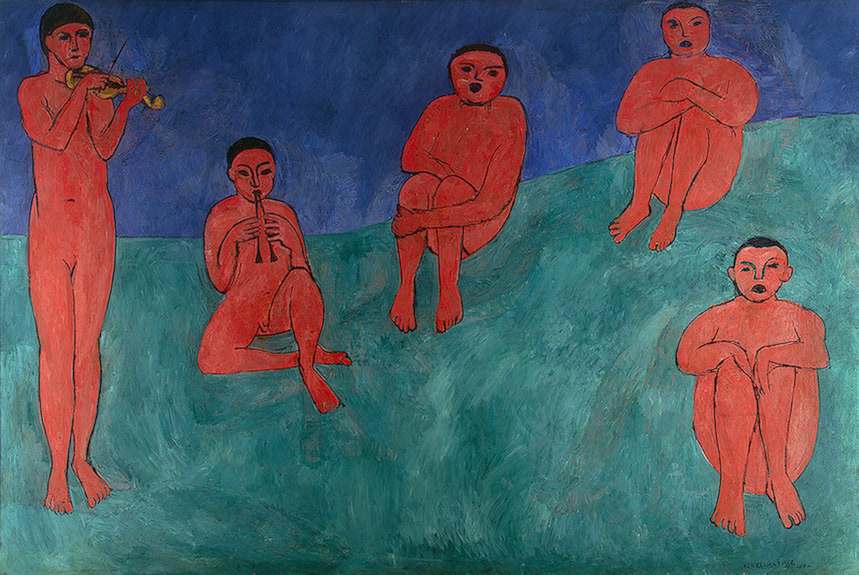
Music, 260x390 cm, 1910
Matisse made the painting without any preparatory sketches, and thus the painting bears many traces of modifications. One can virtually trace the steps Matisse took to find the intended effect. Like in Dance, the aim was to show man's attainment of a state of completeness by immersion in creativity.
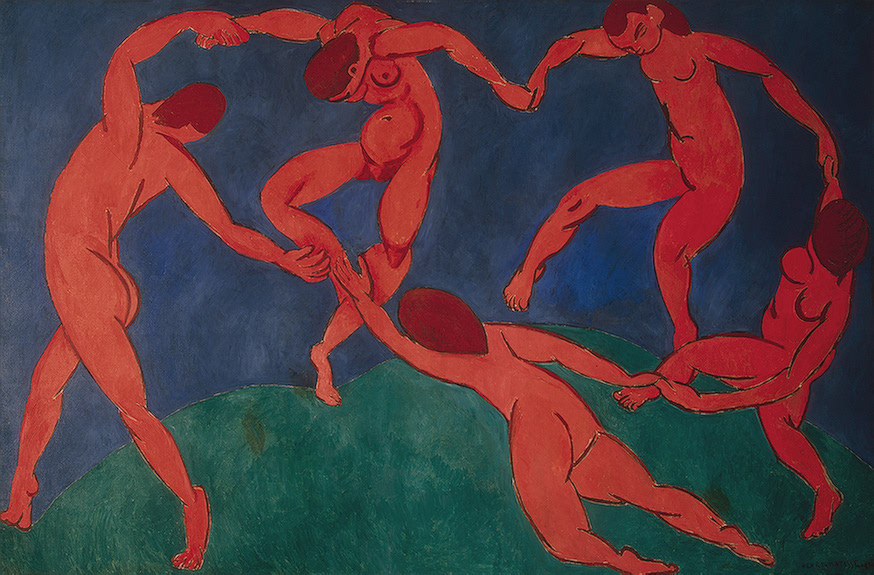
The Dance, 260x390 cm, 1910
The canvas' five dancing figures, painted in a strong red, are set against a highly simplified green landscape and deep blue sky. It reflects Matisse's incipient fascination with primitive art, and uses a classic Fauvist color palette: the intense warm colors against the cool blue-green background and the rhythmical succession of dancing nudes convey the feelings of emotional liberation and hedonism. The painting is often associated with the "Dance of the Young Girls" from Igor Stravinsky's The Rites of Spring. [1977]
Emil
Nolde, (born Emil Hansen) (1867-1956)
München
Pinakothek
der Moderne
1910
The
Pinakothek der Modernen is Munich's new (2002) venue for 20th-century
art. It houses a collection of "classical" modern
paintings, which, however, cannot compete in size, selection, and
quality with, e.g., that of the Museum Ludwig in Cologne, not to
mention MOMA in New York. One reason is architectual: the small
exhibition rooms cramp the viewer.
To make up for the unexciting
in-house collection the museum has mounted a number of outstanding
special exhibitions among them the 2007 a "Beckmann in
Amsterdam" show.
A second museum for contemporary art will
open 2011.
Among the notable permanent holdings are several
wildly luminous paintings by Emil Nolde.[2002]
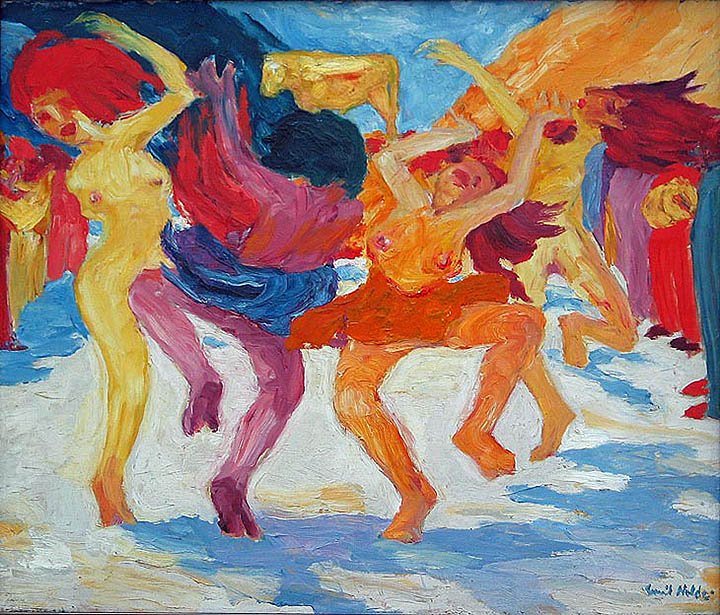
Emil
Nolde, Dance around the Golden Calf, 1910
Vasily
Kandinsky
The
Way into
Abstraction
Museum
Lenbachhaus
München
1909-1913
We are fortunate
that, when Kandinsky fled Munich for Moscow in 1914, le left his
entire body of paintings from the Munich years with Gabriele Münther
in warehouses in Müchen – where they survived both World Wars and
the Nazi years. They are now housed in the Lenbachhaus, one of
Munich's secrets. They comprise a unique record of Kandinsky's way
into abstraction [1972, 1994, 2000]
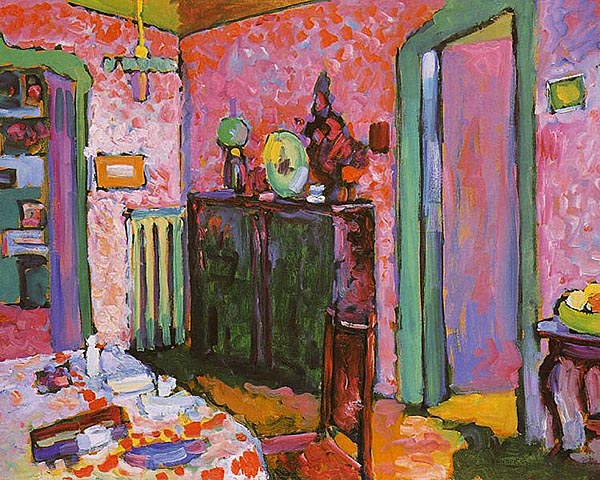
Diningroom,
Ainmillerstr 31, 1909
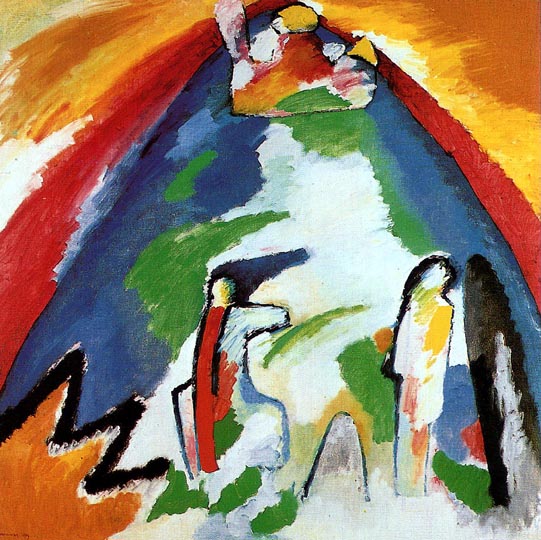
The Holy Mountain,
1909
The
Development of Composition VII, 1913
Among
his paintings at the Lenbachhaus Composition VII takes a special
place
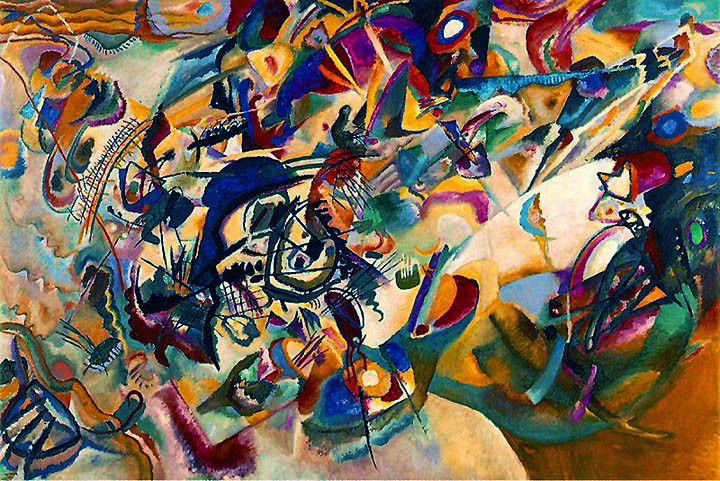
Composition
VII, Vers.1 (78x100cm ) 1913
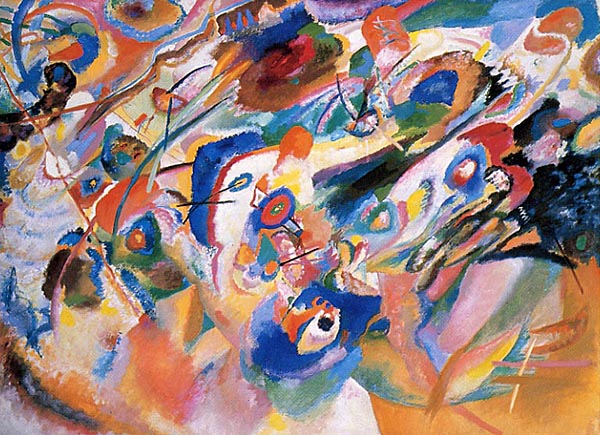
Composition VII, Vers.2
(100x140cm) 1913
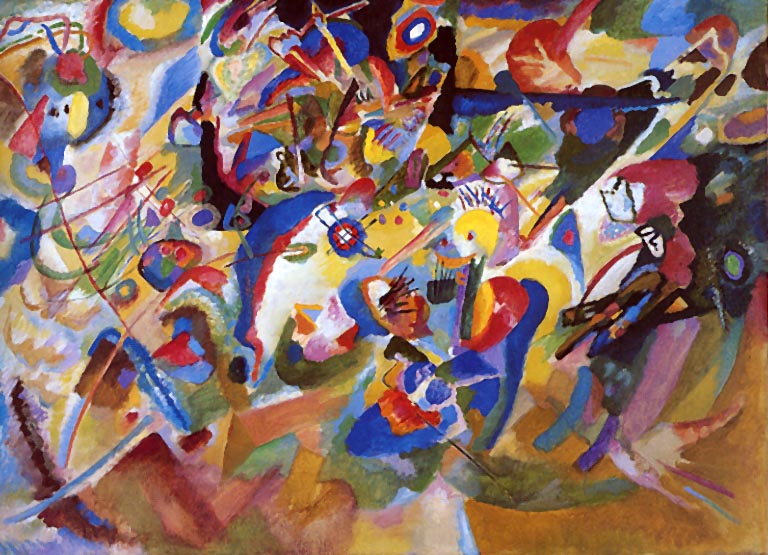
Composition VII, Vers.3
(90x125 cm) 1913
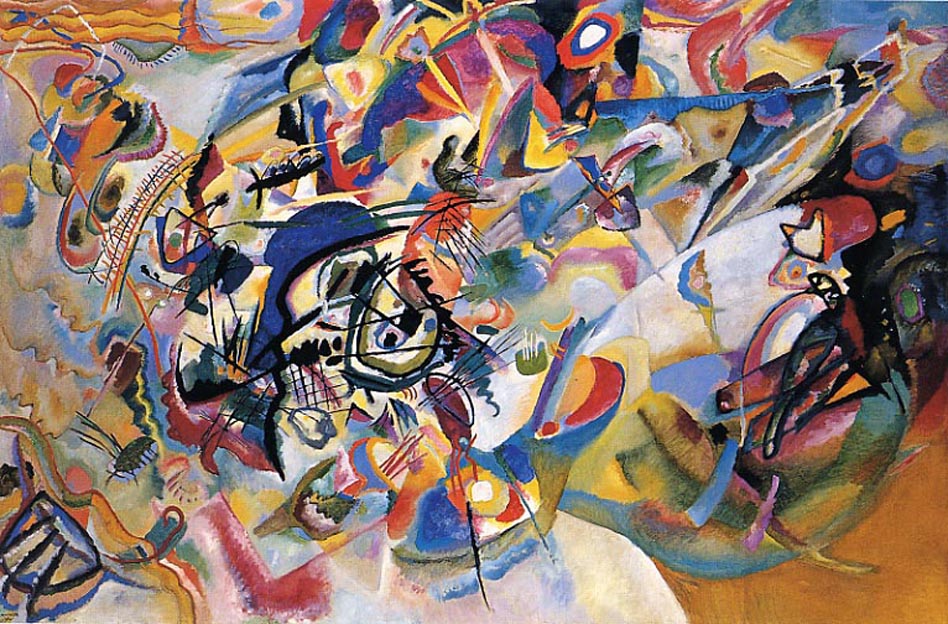
Vassili
Kandinsky, Composition VII, Final Vers. 4, Moscow, Tretyakov Gallery,
200x300cm, November 25-28, 1913
In
terms of labor, complexity, and subjective involvement Composition
VII must be considered Kandinsky's major achievement.
Work on
the preliminary versions of this painting began as early as 1909. We
know over thirty drawings, watercolors and detailed studies related
to Composition VII. There are sheets which invariably repeat one
single curved line; others show schematic outlines of the main
structural elements of the composition; still others contain detailed
plans for preparing the canvas. Despite their chaotic, spontaneous
appearence he left nothing in these paintings to chance - no
curlicue, form, or color. Composition VII combines thematic pieces
from The Resurrection, The Last Judgment, The Deluge and The Garden
of Love in an operatic outburst of pure painting.
Kandinsky
began painting the 200x300cm final Version on November 25, 1913, It
was finished three days later on November 28, 1913. A stupendous
labor. Gabriele Münther recorded the process in a series of
photographs, which are kept at the Lenbachhaus together with all
variants. The final painting is now owned by the Tretyakov Gallery in
Moscow. [1977]
Amedeo
Modigliani, 1884-1920
Nudes, 1917-1918
Fascinated by Modigliani's portraits since childhood, I once set out to collect all of his nudes: at least 16 gorgeous women from an occasional cocotte to regal Alexandra, in every position imaginable. Whenever he ran out of money, he would paint and sell another one. He was especially needy between 1917 and 1919.
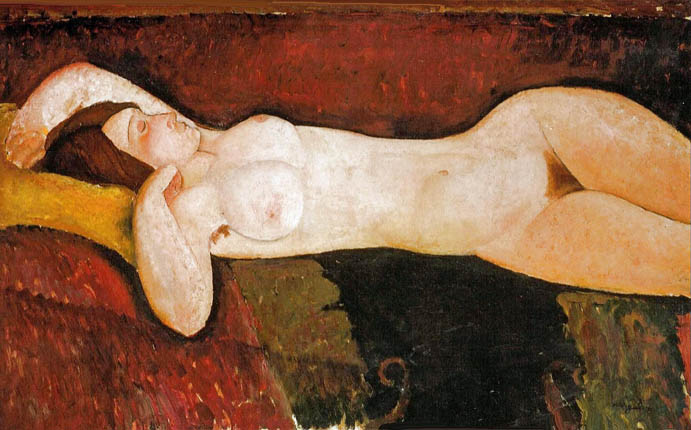
Grande
Nude 1917, MOMA, New York
His most luscious nude is the delight of MOMA, New York.
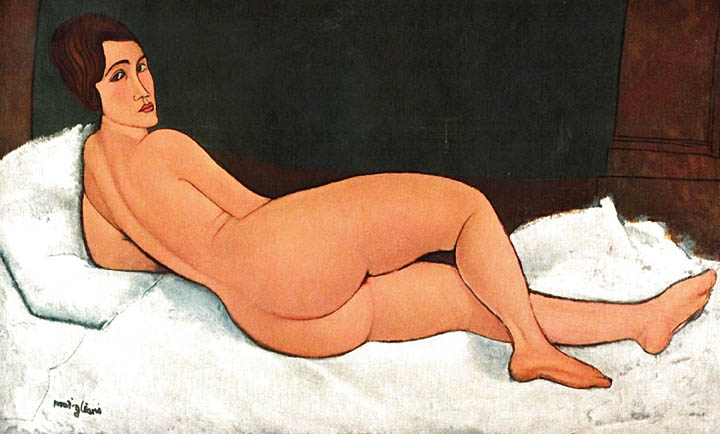
Nude lying on her left
side (“Alexandra”) 1918, private collection
The second one I saw only once in a chance encounter in New York. I fell in love with her elegance and bearing and made her the heroine of my novel "Konrad and Alexandra". - She was last seen when she was sold to an anonymous collector for US$ 26.8 Mill. at Christie's NY in February 2009....
München
Pinakothek
der Modernen
Special Exhibition
Winter 2007
Max
Beckmann (1884-1950)
“Exile in
Amsterdam, 1937-1947 “
The Beckmann exibition
in Munich 2007 was the first comprehensive presentation of two-thirds
of Beckmann's work since the Degenerate Art Exhibiton in July 1937 in
the same town. For me it became an eye-opener. I have seen single
works by Beckmann in New York, Los Angeles, Amsterdam, and Berlin but
had never been able to connect these enigmatic yet intellectually
challenging canvasses. [2007]
After having been declared a
degenerate Artist in 1937 - Hitler called him a "cultural
Bolshevik" - and 500 of his paintings had been confiscated, he
and his second wife Mathilde (Quappi) von Kaulbach fled to Amsterdam,
where they kept a very low profile. Beckmann barely suffered Holland
- and vice versa - but he would spend ten of his most productive
years there, suviving by selling an occasional painting through
underground art dealers. He never returned to Germany. In 1948 he was
finally admitted to the US. He died in New York in 1950.
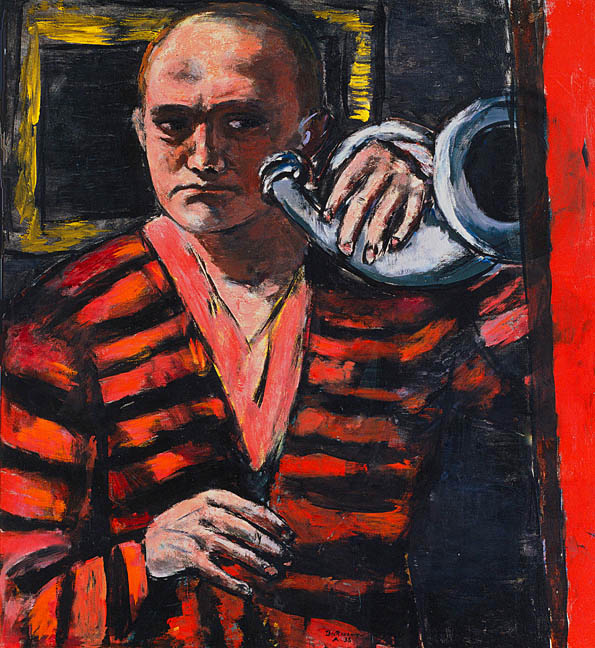
Max
Beckmann, Self-Portrait with Horn, 1938, 100x101cm
Neue Galerie,
New York
Quappi and Beckmann have made it to Amsterdam, yet he hesitates to blow his horn. There will be no hiding from the murderers of his time.
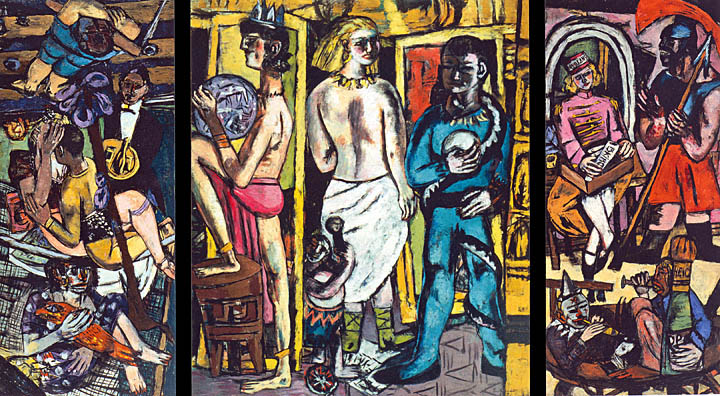
Acrobats
Triptych 1939, 200x170cm,
Saint Louis. MO, Museum of Art
Beckmann's diaries from these years are replete with accounts of his frequent visits to cabarets, carnivals, and the theater. On one level, these distractions offered temporary relief from the horrors of the war. On another level Beckmann regarded them as allegories of human existence. Thus, his paintings from these years - some of the most important works of his career - are abundant with subjects whose identity is both constructed and obscured by masquerade.
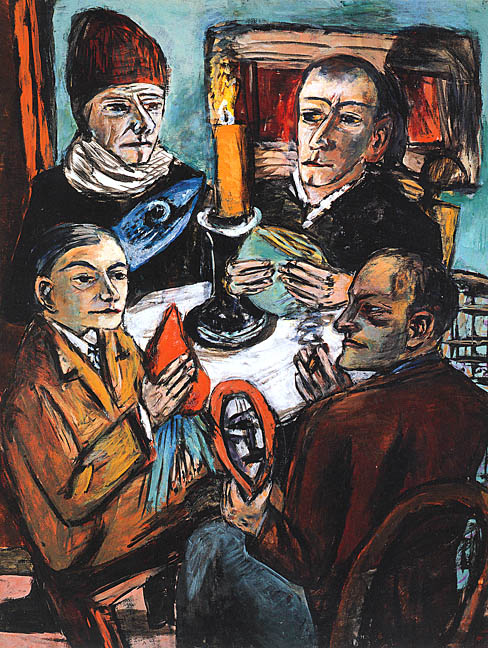
Artists
with Vegetables, 1943, 150x115cm
Washington University, Saint
Louis, MO
A spiritual seance among artist friends during an air raid. The burning city is seen through the window. Each offers a symbolic vegetable. The emotional relationship between the four is as cold as the room. Beckmann holds a mirror showing a diabolic face. He sees himself as the recorder of an increasingly surrealist world.
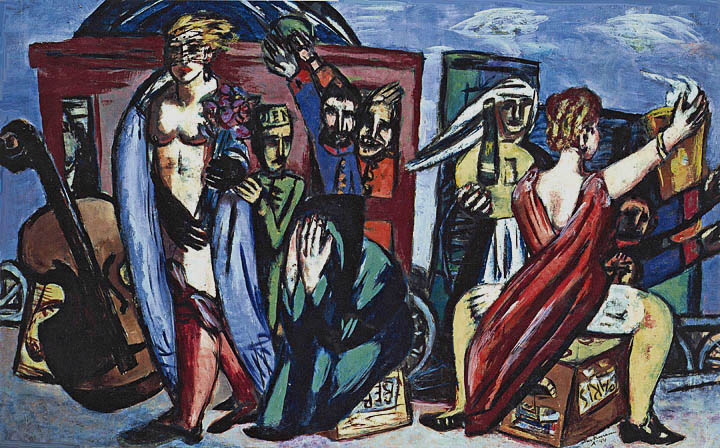
The
Journey 1944, 145x90 cm, Private collection
By 1944 his situation had become hopeless. A train station. People try to flee, but the trains are occupied by German soldiers with raised arms. Quappi, his wife, walks forward determined to save them. A woman with splayed legs hails a ride to Paris. A nurse offers a bottle of mineral water and a vial of poison pills. Amid this confusion Beckmann sits inactive on a trunk labelled Berlin hiding his head in despair.
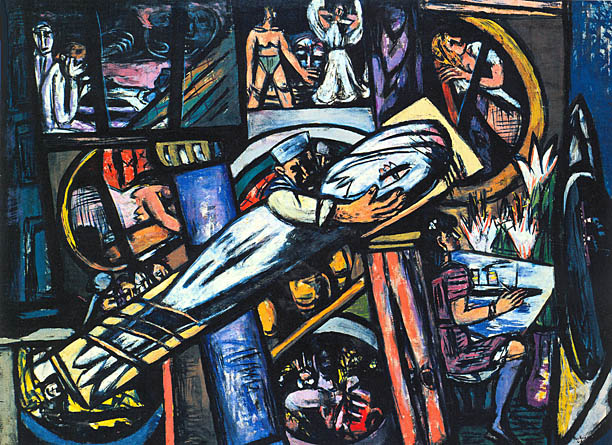
Cabins,
1948, 190x140cm,
Kunstsammlung Nord-Rhein-Westfalen, Düsseldorf
In 1948 Beckmann and Quappi were finally allowed to emigrate to America. Beckmann felt like a fish tied up on board of Katherine-Anne Porter's "Ship of Fools" – He could not adapt to the new country. Two years later Beckmann died of a heart attack in New York.
Rene
Magritte, 1898-1967
Le chef dóeuvre ou Les mysteres de
l'horizon
Frederick R. Weisman Museum
Los
Angeles
1955
Two
representatives of Belgian "Surrealism:” Magritte and Delvaux

Le
chef d'doeuvre ou Les mysteres de l'horizon, 48x63 cm
Magritte was the more inventive and sophisticated, an allegorist with an unlimited imagination. His early work (1915-18) was in an impressionist style, followed by nudes in the futurist/cubist manner (1920-24). During WW II (1940-48) Magritte supported himself through the production of fake Picassos, Braques and Chiricos, a fraudulent repertoire he was later to expand into the printing of forged banknotes during the lean postwar period.- After 1948 he returned to Surrealism in earnest. More at: Wikipedia
Paul
Delvaux (1897-1994)
Les
Rendez-vous de'Ephese (The Meeting at Ephesus)
Foundation
Delvaux,
St-Idesbald, Brussels
1973
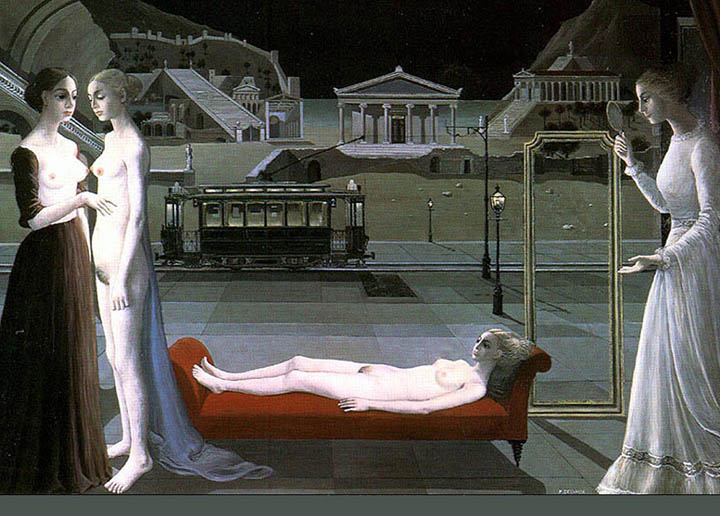
Les
Rendez-vous de'Ephese (The Meeting at Ephesus), 1973
By
comparison Delvaux, despite that he reached an age of 94, preserved
his visions of idealized virgins in settings of trains, street cars,
parks and other fairy-tale fantasies often watched by bespectacled
professors and photographers.
More at: Wikipedia
and Foundation
Delvaux in St-Idesbald.
Laura
Hernandez
OMNIA,
Solo Exhibition of her Paintings and
Sculptures
Museum
of Latin American Art (MoLAA)
Long Beach CA,
1998
Laura
Hernandez was born in Oaxaca, Mexico on September 6, 1960. She has
exhibited in Mexico, Germany, and the US. This was her first large
solo exhibition in the US. Parts of it were later shown in Bochum,
Germany. More on Laura's
website
These photographs were taken by RWFG at MoLAA in
Long Beach, CA in November 1998. Lacking a catalog and information on
the artist, they are without captions. Omnia means "everything".
The exhibition in Long Beach covered 2 large rooms and their
connecting hallways, an area of about 12'000 square-feet. The 7 heads
are each about 8 feet tall. They are made from papier mache in the
fashion of Mexican pinatas and painted with oil paints and mixed
media. Their models are the ancient "Olmec" heads of
Mexico.
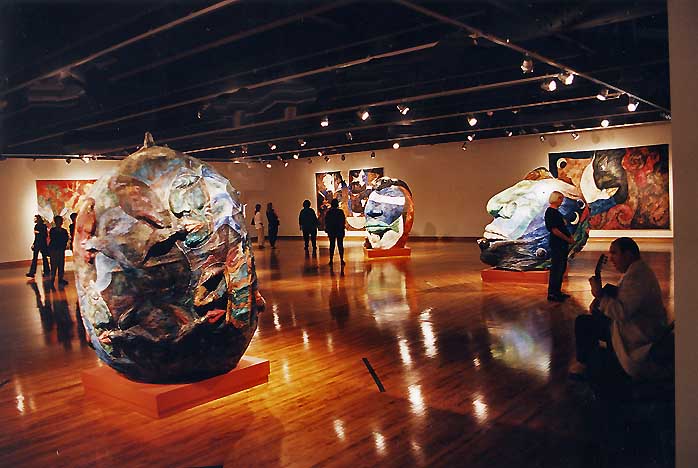
OMNIA
at MoLAA, overview Nov 1998
Years after this event I searched for Laura in the internet. I found her through friends in Amsterdam. She had no website at the time and putting my photos at her disposal I urged her to set one up (viz. the link above). It was then that I found out that the container with the entire OMNIA show had been stolen from the Hapag-Loyd warehouse in Bremerhaven - uninsured.... Unconfirmed speculation has it that the objects disappeared in the Russian market. These photos are the only record of most of these heads and paintings.
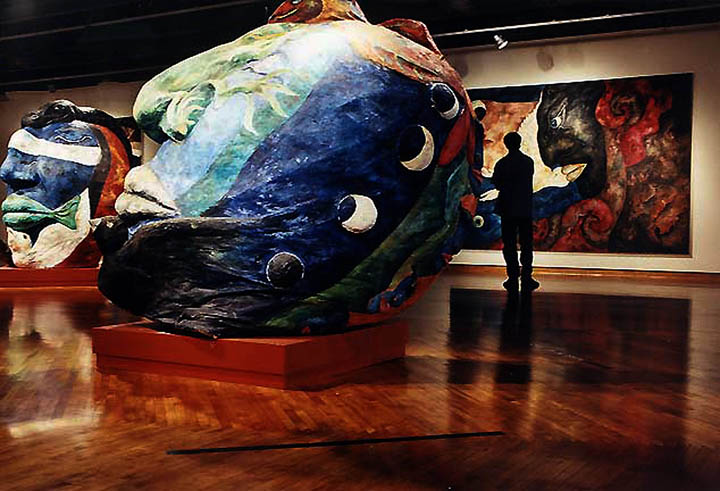
The
Moon-God and Blind-folded Man
Marc Hermans is admiring the
painting
A friendship
between Laura and us developed, whenever she passes through
California she visits us in Pacific Palisades.
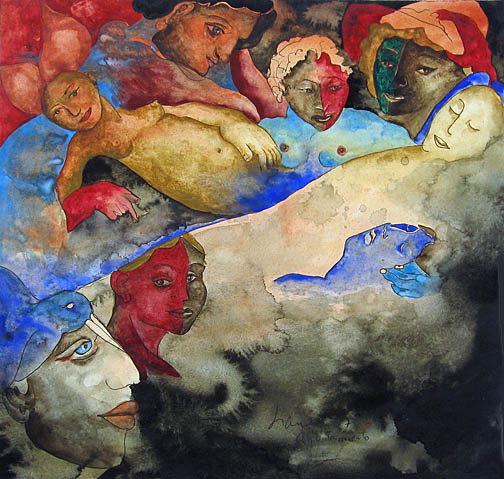
On
her last visit Laura presented me with this watercolor, Amsterdam
1976.
Fredrick
Weisman Foundation
Los Angeles
Between 2002 and
2008
Barbara worked as docent at the
Fredrick Weisman Museum
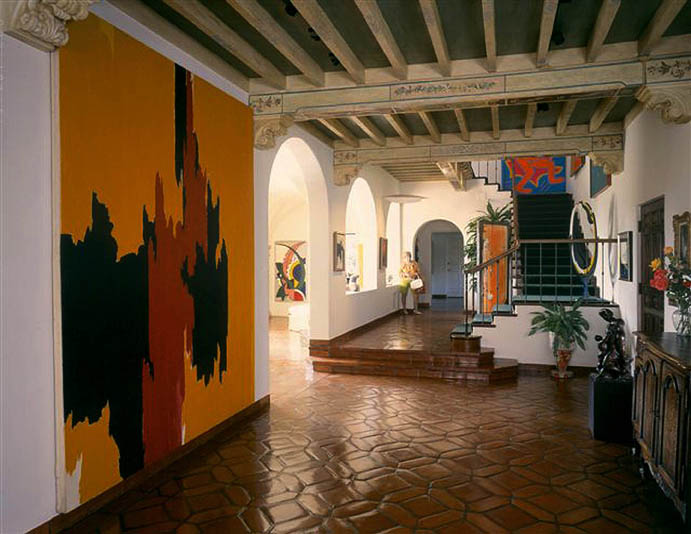
Entrance
hall of the museum
The
private museum can be visited by arrangement through:
Frederick
R. Weisman Foundation
Gerhard
Richter (1932-)
"Wald" (Forest), catalogue
raisonne CR
892
12 untitled abstract paintings
oil on canvas, 197x132 cm,
2005
Special
Exhibition 2007
"From Caspar David Friedrich to Gerhard
Richter: German Paintings from Dresden."
Getty
Center
Los
Angeles
Privately owned individually, the 12 canvasses will revert to the Museum of Modern Art, New York
Richter's opus CR 892,
named "Wald", is one of his most elegant and beautiful
sets. If seen together in one room the 12 large canvasses make an
overpowering impression of beauty and joy on the viewer. The small
size of my reproductions cannot convey this impression.
The
Getty Center in Los Angeles in 2006-2007 displayed the twelve
paintings together with the romantic-spiritual paintings of Caspar
David Friedrich (1774-1840) hung in one high room. A unique
experience - of the sublime beauty of Richter's paintings.
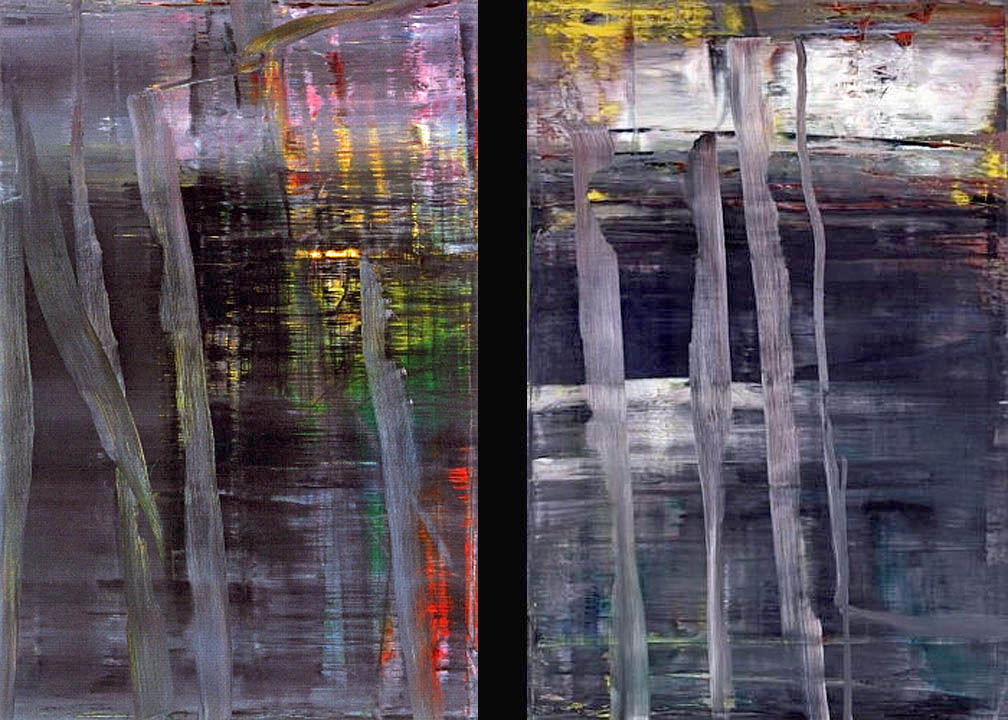
CR 892,1and 2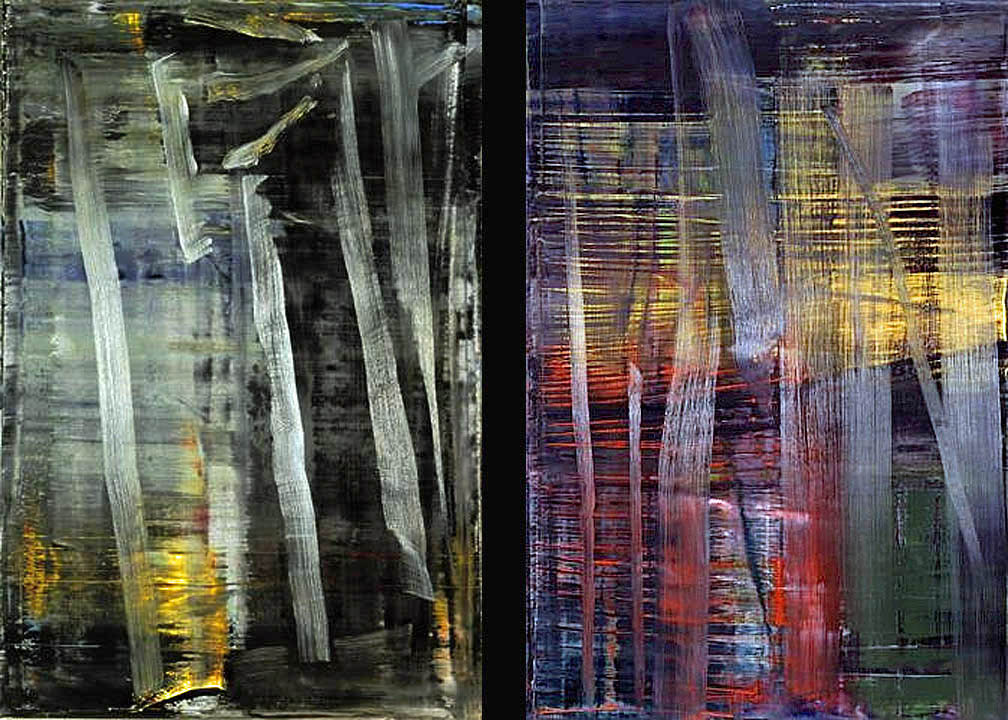
CR 892,3 and
4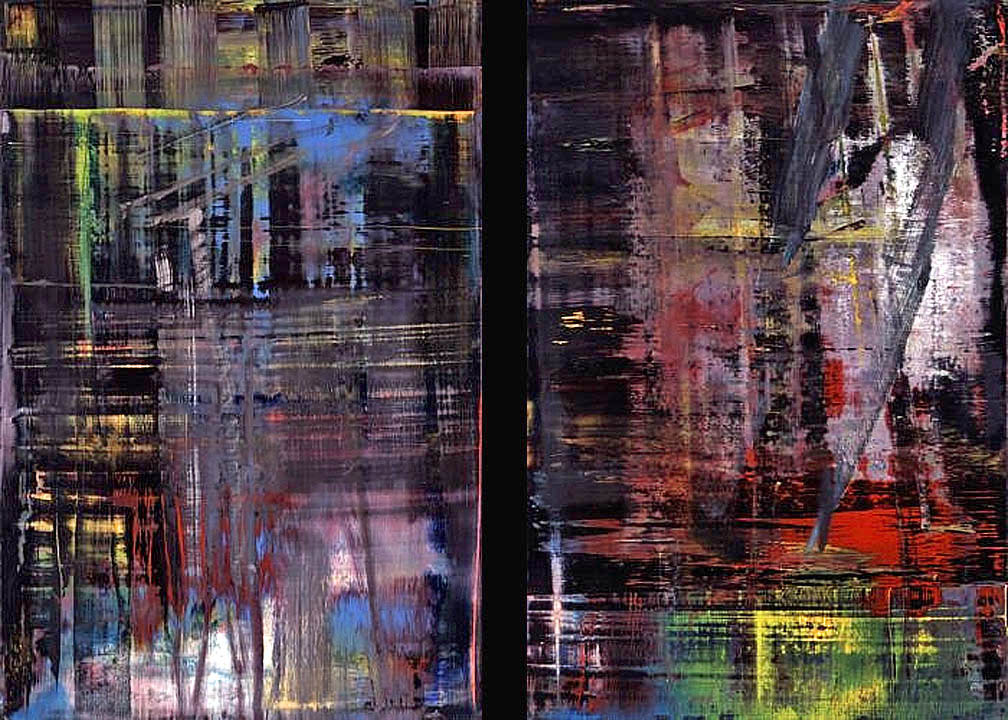
CR 892,5 and
6
CR 892,7 and
8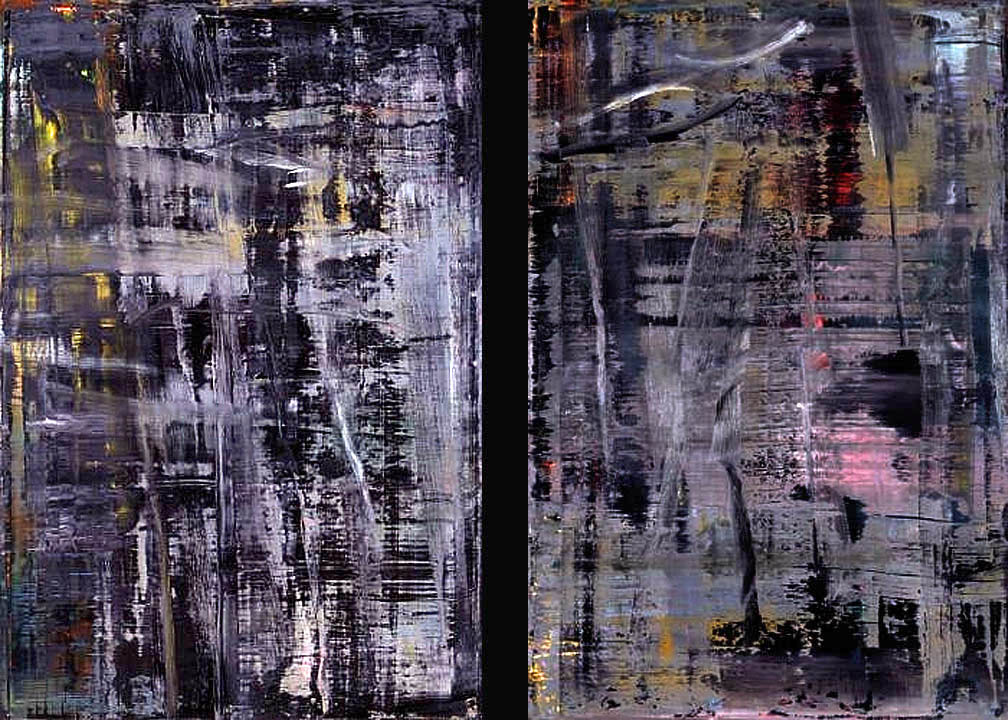
CR 892,9 and
10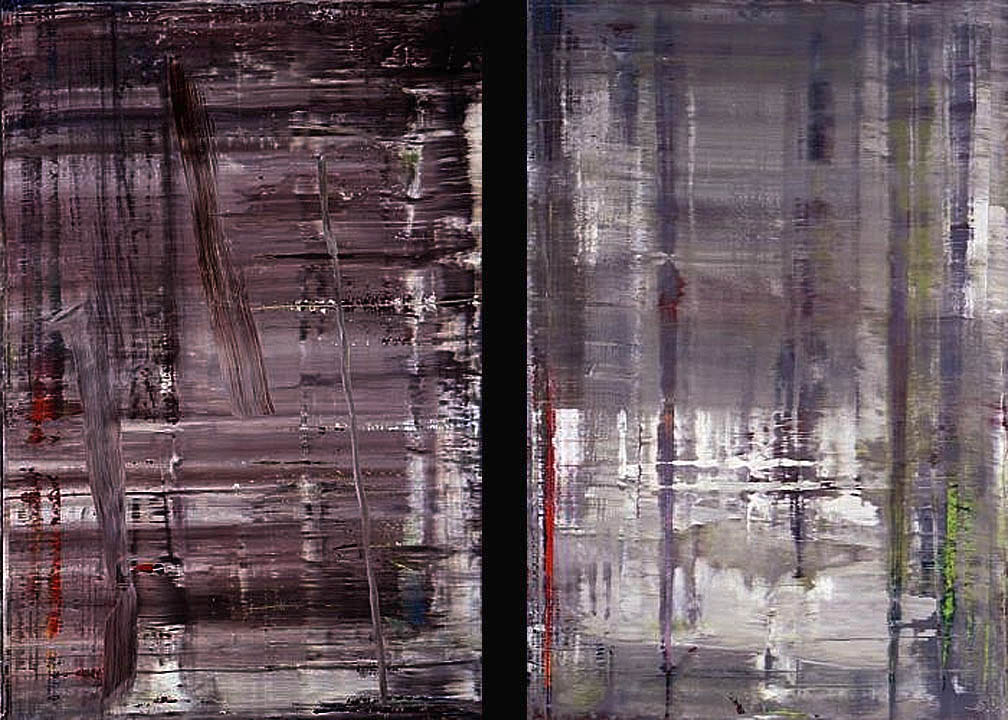
CR 892, 11 and 12
Richter,
in one of his more arrogant moments, claimed that "Wald"
and a second large set of oils he named "Cage" (2006) were
the
end of painting as we know it.
-
There may be some truth to this provocative statement: If the End can
be that beautiful, so be it.
For
more on Richter's work see Gerhard
Richter